


















Grupo Folklórico de USC, made up of students and community members, dance at Noche de Cultura during USC’s Latinx/e Heritage Month in October. Formed in the 1970s, the group performs traditional Mexican dances to showcase cultural pride at USC.
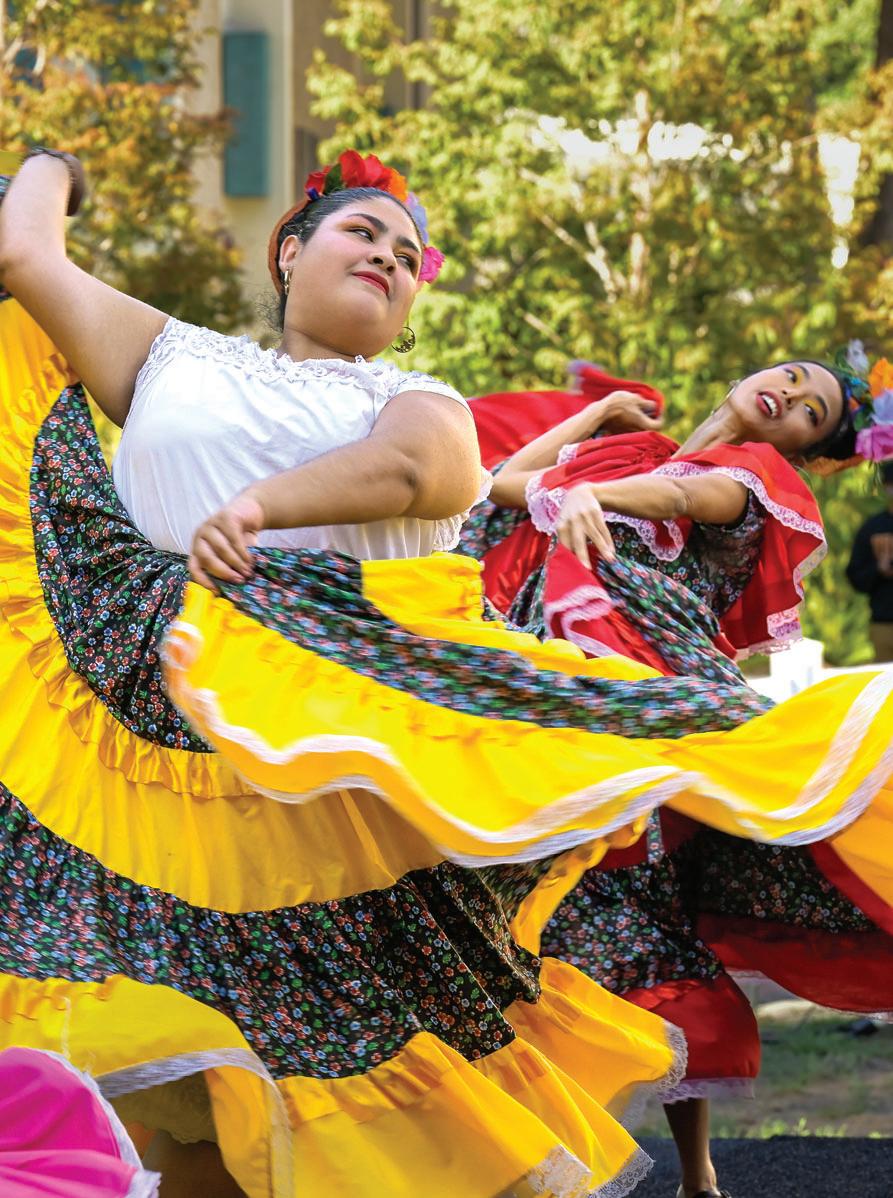
BY
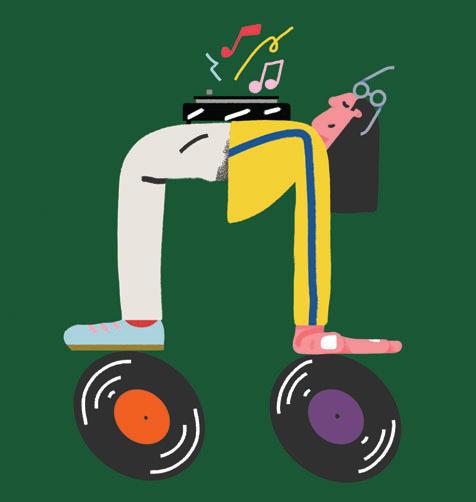
More than reading Douglas Coupland or mourning Kurt Cobain, the true test of one’s membership in Generation X is this: How much of “California Love,” the 1995 Tupac Shakur hit, can you recite from memory?
Today, Gen X’s kids are rattling off bars from five decades’ worth of hip-hop artists: from Rakim to Ice Cube, from Missy to Nas, from Biggie to Eminem, from Jay-Z to OutKast, from Nicki to Kendrick, from Future to Megan. The past year’s celebration of hip-hop’s 50th anniversary has made it clear that — for about the bazillionth time — what started as an innovative, transgressive Black art form has become mainstream popular culture across the United States and the world.
Though hip-hop was born in New York City, by the ’90s, Los Angeles had become an epicenter of the movement’s evolution and revolution — and USC was there for all of it. As Chinyere Cindy Amobi and Rachel B. Levin’s cover story in this issue of USC Trojan Family Magazine details, Trojan faculty, students, alumni and friends
have been intimately entwined with the growth of hip-hop culture in ways both obvious and subtle.
Indeed, the hip-hop ethos of sampling, mixing and crossfading genres and source material dovetails perfectly with the spirit of interdisciplinary inquiry and rigor at USC. The arts play a key role in USC President Carol Folt’s vision for the university — with its six arts schools and newly created position of vice provost for the arts — as a vibrant hub of creative energy for Los Angeles and the world.
We know you’ll enjoy the article, as well as illustrator Temi Coker’s stunning cover and interior art for the piece. And if you want to blast California’s unofficial state anthem (which just so happens to feature Dr. Dre, co-founder of the USC Jimmy Iovine and Andre Young Academy) while reading it, so much the better.
Ted B. Kissell
Editor-in-Chief
USC Trojan Family Magazine
The magazine of the University of Southern California
EDITOR-IN-CHIEF
Ted B. Kissell
CREATIVE DIRECTOR
Jane Frey
MANAGING EDITOR
Lilledeshan Bose
ASSOCIATE EDITOR
Chinyere Cindy Amobi
COPY EDITOR
Cord Brooks
PRODUCTION MANAGER
Mary Modina
INTERACTIVE CONTENT MANAGER
Edward Sotelo
VISUALS EDITOR
Caleb Joel Griffin
STAFF PHOTOGRAPHER
Gus Ruelas
INTERACTIVE MARKETING DIRECTOR
Anna Clark
DESIGN AND PRODUCTION
Pentagram
CONTRIBUTORS
Chloe Barker
Greg Hernandez
Laurie McLaughlin
David Medzerian
USC Trojan Family Magazine 3434 S. Grand Ave., CAL 140 Los Angeles, CA 90089-2818 magazines@usc.edu
USC Trojan Family Magazine (ISSN 8750-7927) is published in April and October by USC University Communications.
MOVING? NEW EMAIL? Update your preferences at trojanfamily.usc.edu/subscribe
ADVERTISING: Visit trojanfamily.usc.edu/advertise for information.
4 Seen and Heard
K-pop star Aiki visits USC, a song for the L.A. Memorial Coliseum and more.
5 Five Things You Need to Know
In these classes, the way to a student’s brain is through their stomach.
News
A map of L.A.’s indigenous past gives us clues to the present.
A Wecome Home
Three Trojan transfer student stories tell of dreams come true. 14 Sustainability at the Forefront
How USC is sustaining a green campus through research, collaboration and policy changes.
Wherever hip-hop has made its mark on American culture — from music, dance and film to entrepreneurship and scholarship — you’ll find USC faculty, students and alumni. (More on p. 20.)

Alumni News
Results of the USCAA alumni survey help forge a path forward; the USC Latino Alumni Association celebrates its 50th anniversary; and more.
64 What Does the Fox Say?
A summer internship on scenic Catalina Island involves surveying native plants and efforts to revive the island’s fox population.

How USC became a pioneer in hip-hop scholarship and an incubator for innovation in culture, the arts and commerce.
By Chinyere Cindy Amobi and Rachel B. Levin
A vibrant collection of USC programs infuses arts activities into health care to soften the hospital setting, support patients’ recovery and lift their spirits.
By Rachel B. Levin
The largest river restoration and dam removal project in U.S. history is underway along the Klamath River, which runs through Oregon and California.
By Nina Raffio
Trojan student-athletes receive care from L.A.’s top sports physicians.
By Grayson Schmidt
Aiki (Kang Hyein) is a one-name celebrity in her native South Korea, creating signature moves for some of K-pop’s biggest musical acts. In October, she came to the USC Kaufman School of Dance to offer Trojans a crash course in K-pop dance via a weeklong residency of workshops. In turn, the students gave Aiki a window into American dancers’ style and flair.
“Dance is a second language,” said Aiki, a veteran of NBC’s World of Dance whose viral videos garner millions of views. “You’re able to communicate just by the movements. And everybody’s able to pick it up just through the counts.”
The visit was a prelude to a danceintensive December study abroad program in Seoul for Trojans. “Our students understand now that a career in K-pop is a possibility, which expands pathways for them into the performing arts industry,” USC Kaufman Dean Julia Ritter says.
She notes that studying with a renowned artist like Aiki and traveling to South Korea are invaluable experiences for the student dancers: “It makes them more versatile artists and better world citizens. When we say that USC Kaufman is international, we mean it.”
RACHEL B. LEVIN
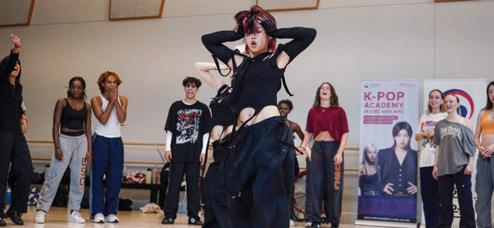
In comedy, being funny isn’t everything. That’s the message from Spoiler Alert, the long-form narrative improv comedy troupe that performs weekly at Tommy’s Place.
“Yes, we want to make the audience laugh. But we also want to make them cry, and gasp, those kinds of reactions,” says Josh Morton ’25. “Ultimately, telling a story is more than just comedy. While we are all very funny, it’s not the main priority for us.”
Instead, Spoiler Alert improvises a new, hourlong three-act play each week. Each of these “episodes” tells a story with compelling characters and a beginning, middle and end.
“The most successful episodes feature characters that are not making a joke of
themselves,” says Valentina Navarro-Marsili ’26. “It’s difficult to go up in front of a group of people and really care about what you’re saying. But if your character doesn’t care about anything, or if you don’t care about what your character has to say, it breaks the illusion.”
Spoiler Alert has been at USC’s University Park Campus since 2011, when the group performed on the steps of the Pertusati University Bookstore. “We haven’t gone far,” Morton says. “Though Tommy’s Place is substantially nicer.” GEOFFREY WARING
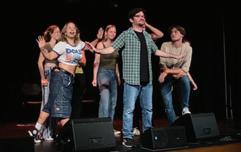

When it came time to record “We Came to Bring the Fire,” written for the Los Angeles Memorial Coliseum’s 100th anniversary, songwriters Ella Collier ’22 and Sam Vendig’17 knew where to turn: their alma mater.
They worked with Sean Holt, vice dean at the USC Thornton School of Music, to assemble their team — which included a choir of USC Thornton singers arranged by alumna Tehillah Alphonso ’20, along with student musicians and a production team of the music school’s faculty.
The song represents the ties between the university, the Coliseum and the collective spirit of the USC community — so it was exciting that the project included alumni, students, faculty and USC partners across the university, says USC Thornton Dean Jason King. “The fact that the project has brought so many people together who are in some way connected to Thornton’s past and present seems like a fitting way to celebrate the centennial.”
DEANNA GASPARYAN
It’s not farfetched to say that food is the most important thing in the world. It shapes our bodies, defines national economies, drives scientific research and environmental choices. At USC, some of the most interesting courses on history, biology and sociology are taught via food. CHLOE BARKER


USC Dornsife’s Grayson Jaggers teaches “The Biology of Food,” in which students explore the science of taste and aroma. A lab portion provides a hands-on introduction to rudimentary cheese making, fermentation of foods and laboratory analysis. Jagger’s goal? To make biology more accessible to non-science majors.






USC Dornsife’s Michael Petitti teaches a course on food and class in Los Angeles to spotlight the complexity and struggles of the city as a global food hub. Students work at a Compton farm and look for edible foliage to learn about food insecurity, housing and consumption.
“Everyone eats, but so often we don’t stop
to think about why we eat what we do,” Leah Hochman says. Her class at USC Dornsife explores how food reflects identity, family and community traditions; assignments include tracing a meal’s ingredients to their origins and volunteering at a food pantry.



USC Leonard Davis School of Gerontology
Professor Valter Longo looks at the impact nutrition and genetics have on longevity and diseases related to aging. A Maymester term is held in Liguria, Italy — Longo’s homeland — where the local diet is healthy pescatarian and a record proportion of people are older than 65.







Sarah Portnoy uses food to deepen students’ understanding of Spanish vocabulary and Latino culture. Field trips to explore Olvera Street and Boyle Heights in Los Angeles are centered on food culture and justice, and span five classes across the USC Dornsife College of Letters, Arts and Sciences and the USC Annenberg School for Communication and Journalism.

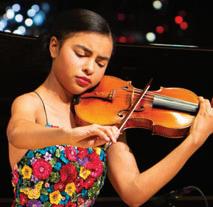















Classical music has the power to inspire and enhance wellbeing for everyone. Broadcasting via radio, apps, website and through our numerous streams, Clasical California KUSC/KDFC operates the #1 classical radio network in the country. We are with you wherever you go!








Listen now

BUT NET

the
Foundation, the
USC experts look at the region’s natural ecology before European settlers arrived.
BY DANIEL P. SMITH
The perspective of Indigenous peoples ranks high among the features of a new historical mapping project of the Los Angeles region, one that offers a resource to guide local planning efforts involving sustainability, habitat restoration and climate change preparation.
Blending insight from representatives of local Indigenous communities, extensive
archival research and contemporary technologies such as spatial analysis and modeling, the long-running project headed by the Spatial Sciences Institute (SSI) at the USC Dornsife College of Letters, Arts and Sciences has developed the first systematic map of L.A.’s natural ecology.
“Mapping Los Angeles Landscape History” offers a comprehensive view of
the region’s natural environment and how Indigenous people interacted with the land and each other in a sustainable way before the arrival of European settlers.
The three-year collaborative effort drew on expertise from USC and four local public universities — UCLA, Cal State Northridge, Cal State L.A. and Cal State Long Beach — as well as three Indigenous tribes: the Barbareño/Ventureño Chumash, Fernandeño-Tataviam and Gabrieleño-Kizh.
“This work gives rich insights into the ecological and cultural history of Los Angeles along with valuable context that should help city planners, land developers or anyone, including the public, ensure their projects don’t repeat the mistakes of the past,” says John Wilson, founding director of SSI and a project co-principal investigator.
The report also delivers important context and framework, says Philip Ethington, professor of history, political science and spatial sciences at USC Dornsife and the project’s principal investigator. It provides residents, leaders and policymakers alike an understanding of how the natural regional ecology operates, which can inform thoughtful and climate-sensitive restoration and sustainability efforts.
Leaning into the work of biologists, geographers and historians, including those representing Indigenous tribes, the project includes a topographic reconstruction of the L.A. Basin from Ventura County to Orange County; Indigenous trade networks and travel pathways; plant habitat models; and more.
One notable finding: Ventura Boulevard and the 101 Freeway corridor were well-traveled paths long before Europeans arrived, asphalt covered the ground and automobiles chugged down the roadway.
Tribal scholar Matthew Vestuto, chair of the Barbareño/Ventureño Band of Mission Indians and a co-principal investigator of the report, says the project offers a longer look at what was and inspires what can be.
“I hope our collaborative work ignites a more intimate understanding of place and that people feel more connected to this land we belong to,” Vestuto says. “That way, they love it, take care of it and feel responsible for its health.”
Renowned legal scholar and educator Elyn Saks is a fierce advocate for mental health after being diagnosed with schizophrenia at age 28. BY
NINA RAFFIO
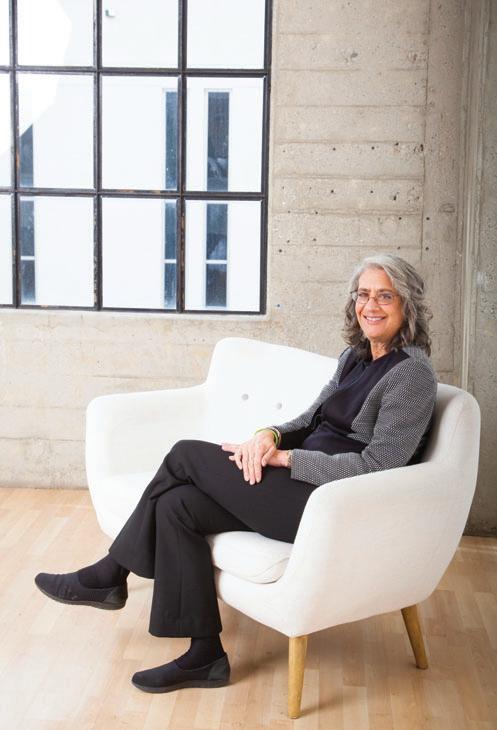
Elyn Saks’ list of accomplishments is as long as it is impressive. She directs the Saks Institute for Mental Health Law, Policy, and Ethics at the USC Gould School of Law and is the recipient of numerous honors, including the prestigious John D. and Catherine T. MacArthur Foundation Fellowship (the so-called “Genius Grant”).
Saks also lives with chronic schizophrenia — a diagnosis she made public with her 2007 memoir, The Center Cannot Hold: My Journey Through Madness. She recently codeveloped a peer-based care navigation service called Mental Health GPS and published findings from the yearlong pilot program. In this interview, she talks about how her lived experience with mental health has informed her lifelong work advocating for systemic change and patients’ rights.
On why she shares her experiences with mental illness: I wanted to write a corrective story about the many faces of schizophrenia and mental illness. I was originally advised to write my memoir under a pseudonym, but I felt that would send the wrong message. I stayed true to that goal and wrote the memoir to give hope to those who suffer from schizophrenia and understanding to those who don’t.
On developing a peer-based care service: Mental Health GPS helps connect callers with appropriate mental health care and avert crisis. Results from the yearlong pilot recently published in the New England Journal of Medicine Catalyst: Innovations in Care Delivery emphasize the importance of peer support. Peers know better than anyone else what it’s like to have these struggles. And they also are less likely to feel stigmatized interacting with each other.
In the future, I would also love to study the downstream effects of the program, including more independent living, more independent working and a better relational life.
On her empirical work around supported decision-making and psychiatric advance directives: That’s where you say, if I get sick, here’s where I want to go, these are the meds that work for me and the ones that I don’t want. Here is who I want to be told. It allows people to be the architects of their own lives. As someone who has had choice taken away, I can attest to its importance.
The year’s biggest literary festival is back! Find your spark at the 2024 L.A. Times Festival of Books, April 20-21 on the USC campus. General admission is free for all ages and reservations open soon for hundreds of events with authors and celebrities.
Scan the code or visit latimes.com/fob to see the schedule and browse ticket packages.
For USC’s transfer students, becoming a Trojan is a dream fulfilled.
BY GREG HERNANDEZ
When Solana Marquez began classes at USC this fall, she felt deeply happy and proud to finally be a Trojan.
“USC had been my dream,” says the junior from the USC Viterbi School of Engineering. “When I was unable to attend coming out of high school, it was really hard.”
As a Latina, Marquez is part of the 27% of transfer students who are from ethnic groups that have been historically underrepresented in American higher education: 17% Latino, 7% Black and 6% who identify with two or more ethnic groups, some of which are underrepresented. In addition, Native American and Native Hawaiian students make up 0.3% of the transfers.
Based on national data from the federal government, USC leads all private research universities when it comes to enrolling transfer students.
Brunold adds that USC remains especially committed to enrolling large numbers of students from California’s community colleges.
“These students’ success at USC continues to prove that the well-worn pathway from community college to private university is a realistic and viable option,” he says.
Students who take a circuitous path to USC often take advantage of campus resources created for transfer students, such as the Transfer Student Assembly, which bridges the gap between transfer students and the greater USC community.
“These students’ success at USC continues to prove that the wellworn pathway from community college to private university is a realistic and viable option.”
In the fall, 1,335 transfer students earned admission to USC, coming from approximately 300 different colleges and universities. About 52% transferred from a community college in California. In the spring, 350 students made the move to USC, with 47% of the transfers coming from nearly 50 different community colleges in California.
— USC DEAN OF ADMISSION
TIMOTHY BRUNOLD
“We gladly welcome students who began their higher education journey elsewhere,” USC Dean of Admission Timothy Brunold says. “We value the diversity of backgrounds, perspectives and experiences that transfer students bring to our classrooms and campus community.”
“There are definitely unique things that transfer students face,” says Alejandra Delacruz Hong, director of Student Equity and Inclusion Programs’ Trojan Success Initiatives. “We want them to know that they have not lost out. There’s plenty of time for them to get internships and for them to build their skill set and their professional network while they’re with us.”
In addition to her classwork, Marquez has been attending career fairs and Trojan Talks, both hosted by the Career Center. She has also found it invaluable to be paired with a mentor through the USC Viterbi Center for Engineering Diversity, which assists in the recruitment, retention and graduation of people from minority backgrounds pursuing engineering degrees.
“There are not a lot of women, especially Hispanic women, in my major,” she says. “I’m really proud that I have been able to get to this point.”




Engineer Stayce Harris ’81 and business executive Reon Roski ’86 joined the USC Board of Trustees in October.
USC alumnae Stayce Harris ’81 and Reon Roski ’86 were elected to the USC Board of Trustees in October.
Harris, an industrial and systems engineer, joins the board after more than three decades of tandem careers and leadership with the United States Air Force and United Airlines, including being the first African American woman to achieve the three-star rank of lieutenant general in the Air Force.
Harris calls joining the board a great honor and responsibility. “The Board of Trustees is such an accomplished group of people,” she says. “I look forward to learning from them and our stakeholders, and contributing more to the university.”
A graduate of USC and Loyola Law School, Roski is chief executive officer of Los Angeles-based Majestic Realty, the largest privately held developer and owner of master-planned business parks in the United States. Roski grew up a Trojan. Her grandfather, Russell D. Garner, and her parents, Edward P. Roski Jr. and Gayle Garner Roski, are USC alumni. Her parents met at USC, and their longtime support of the university includes naming gifts for the USC Roski School of Art and Design and the USC Gayle and Edward Roski Eye Institute. Reon Roski’s children — triplet sons, Austin, Bryce and Grant, 28, and daughter Ashley, 25 — are also USC graduates.

“My whole life has been around USC,” Roski says. Of joining the Board of Trustees, she adds, “It’s been a dream of mine.” CHINYERE CINDY AMOBI AND DAVID MEDZERIAN
In October, USC faculty members Adam Leventhal and Caryn Lerman of the USC Tobacco Center of Regulatory Science received a $20 million grant from the National Cancer Institute to study how tobacco products other than conventional cigarettes, such as e-cigarettes and fruit-flavored oral nicotine products, are used by and marketed to young people.
USC Professor Mahdi Soltanolkotabi received the National Institutes of Health Director’s New Innovator Award last October. The $2.4 million grant will be used to develop new AI-powered algorithms that could lessen the need for higher-strength MRI machines and alleviate suffering for patients with uncommon nerve disorders.
Two studies from the USC Dornsife College of Letters, Arts and Sciences suggest that of the 8 million Americans who have mild cognitive impairment, more than 90% don’t know it — an especially worrisome finding since early diagnosis is key to delaying onset of dementia and Alzheimer’s disease.
An Alzheimer’s diagnosis in a sibling raises the risk of a shortened life span in other family members, according to USC research. The research suggests that dementia itself is not the sole cause of a shortened lifespan, but instead a combination of shared genes and environment.
USC debuts interdisciplinary fashion minor at the USC Roski School of Art and Design.
BY GRAYSON SCHMIDT
For as long as Antonio Bartolome has worked at USC, he has pondered the same question: Why doesn’t USC have a fashion program? A school with such strong ties to the entertainment industry — in a city that’s one of the hubs of the fashion world — seems like the ideal place for such a program.
“People find out that we don’t offer any fashion programs and they’re like, ‘That doesn’t make any sense,’” says Bartolome, the student services director at the USC Roski School of Art and Design.
For the past several years, Bartolome worked with others at USC Roski to bring such a program to the university. That dream became a reality this fall when USC launched its first minor in fashion.
“Roski artists and designers have always possessed a strong vision and a commitment to ethical practices leading to unique and forward-thinking ideas that make me proud and leave me hopeful,” says Haven Lin-Kirk, dean of USC Roski. “I’m excited that we are now offering all USC students an avenue where they may communicate their identities and beliefs through the multisensory world of fashion.”
USC’s program comes out of a collaborative effort between USC Roski and other professional schools including the USC Jimmy Iovine and Andre Young Academy, the USC School of Dramatic Arts, the USC Kaufman School of Dance, the USC Marshall School of Business and the USC Annenberg School for Communication and Journalism.
Though the minor is considered interdisciplinary, it will be housed at USC Roski. Elective options include fashion studies, wearable production, smart fabrics, fashion in extended reality and digital worlds,

costuming, dance and movement, and marketing. The minor may also serve as a path to two forthcoming progressive graduate degrees: the Master of Fine Arts in Fashion at USC Roski and the Master of Science in Fashion Innovation at the USC Iovine and Young Academy.
“Fashion is developing an intersectional identity spanning creative practice, technology, business and culture,” says Thanassis Rikakis, dean of the USC Iovine and Young Academy. “The USC fashion partnership allows our students to engage, explore and expand the intersectional characteristics of fashion.”
As part of the sustainability moonshot, USC also launched the Presidential Sustainability Solutions Fellowship. The five inaugural recipients will pursue an inspiring array of research projects — from protecting salt marshes to promoting climate justice through video gaming.
The new 1,500-square-foot Sustainability Hub is a collaborative, inclusive and multiuse gathering space at USC. BY
When USC’s Sustainability Hub opened last September, USC President Carol Folt welcomed students, faculty, staff and community members by saying, “We’re here because we care about creating a sustainable, livable planet, where we meet the needs of all people.”
Located at the Gwynn Wilson Student Union building at the heart of USC’s University Park Campus, the 1,500-square-foot hub is a collaborative, inclusive and multiuse gathering space for students, researchers and staff focused on advancing sustainability at USC.
GREG HERNANDEZ
The hub is a key piece in Folt’s sustainability “moonshot” for USC. The university currently offers 1,200 sustainability-inclusive courses and has completed multiple solar installations, including one at the Galen Center. Today, the university receives 25% of its electricity from solar-generated sources. USC has also eliminated single-use plastic beverage bottles on campus, resulting in more than 1.5 million of them to date being saved from landfills. Folt also hosts a sustainability internship program, which will have 16 student interns this year.
The appointments include two USC faculty mentors from different schools, dedicated programming, an annual salary, help with relocation expenses, funding for research and a budget to hire student researchers.
“This new program exemplifies the best of what USC can offer: convergent research with meaningful impact,” says Ishwar K. Puri, senior vice president of research and innovation. “These early-career scholars are pairing different disciplines to explore and devise solutions for some of the most urgent climate changerelated challenges faced by humankind. We’re excited that USC can offer them the research expertise and resources to fully investigate these questions.”
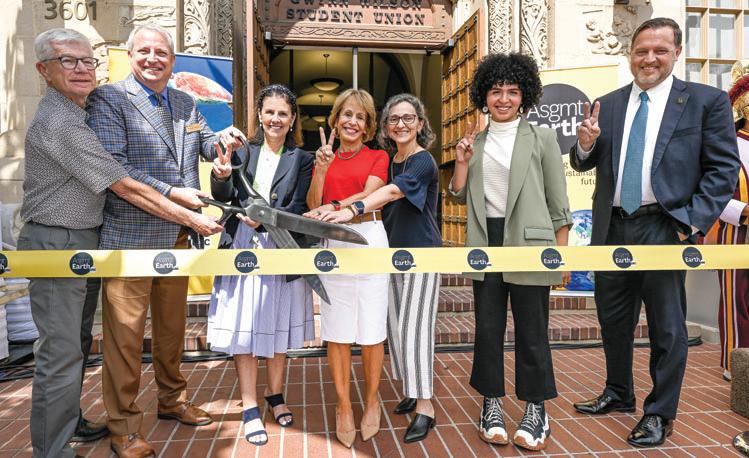
The USC Hotel Garden is growing dozens of fruits, vegetables and herbs for campus use.
Just around the corner from the bustle of Figueroa Street, in an alley behind the USC Hotel, chef Keith Shutta picks a ripe cherry tomato off the vine and pops it in his mouth. “Oh, you can’t beat that,” he says. “You can taste the sweetness, the acidity — it tastes like how a tomato is supposed to taste.”
These tomatoes are part of the revamped USC Hotel Garden, which grows dozens of fruits, vegetables and herbs for campus restaurants, cafes and bars. The garden grows produce in planters filled with locally sourced organic soil,
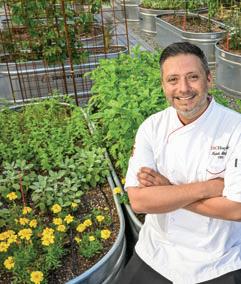
adhering to USC’s commitment to cut water usage 20% by 2028 as part of USC President Carol Folt’s sustainability “moonshot.”
For the spring/summer season, the garden will feature citrus trees, passion fruit vines, heirloom tomatoes, cucumbers, zucchini, shishito peppers and more. A separate herb garden yields basil, parsley, sage, thyme, oregano and chives.
Dirk De Jong, assistant vice president of USC Hospitality and USC Hotel, says the USC Garden shows what’s possible in an unlikely setting. “This is not a large area we’re in, but we’re still able to produce a good amount of food,” he says. “We can still showcase that you don’t need to be in an agricultural area to grow things.” GRAYSON SCHMIDT

Takeaways from USC’s Solutions for a Sustainable Future conference address top climate issues. BY GRAYSON SCHMIDT
At the Solutions for a Sustainable Future conference at USC’s University Park Campus in October, climate experts came together to address three top climate issues: energy and technology, food and water, and human behavior.
“We have ample proof that climate change is a grave threat to our well-being and the well-being of our entire planet, but we have an even greater need to offer solutions. Solutions not only offer the tangible ways to address the challenge, but they also provide hope. Hope drives our motivation to confront climate change, and it is the wellspring of innovation and cooperation.”
— Hoesung Lee, former chair of the Intergovernmental Panel on Climate Change
“[The beef and dairy industries are] our biggest opportunities to put [on the] brakes and turn back the clock on climate change.” — Pat Brown, former Stanford University professor and founder of Impossible Foods, on the beef and dairy industries’ water usage and their impact in California
“We created this concept of nationally determined contributions, and those would be the emissions commitments of each country under the Paris Agreement. We had to use diplomacy to get countries to put in ambitious commitments and then figure out how they were going to implement them.” — Sue Biniaz, deputy special envoy for climate for the Office of the U.S. Special Presidential Envoy for Climate and one of the architects of the Paris Agreement

USC geneticist Marlena Fejzo is one of Time magazine’s 2024 “Women of the Year.”
BY LEIGH HOPPER
USC geneticist Marlena Fejzo, whose discovery of the cause of morning sickness in pregnancy brought international attention to her work, is one of Time magazine’s 2024 “Women of the Year,” the publication announced Feb. 21.
The recognition follows Fejzo’s recent study in Nature, which showed that a hormone produced by the fetus — and the mother’s sensitivity to it — triggers nausea and vomiting during pregnancy.
Up to 80% of pregnant women experience morning sickness, more accurately known as pregnancy sickness since it can occur at any time of day. About 2% of pregnant women are affected by a severe form called hyperemesis gravidarum, or HG, which can cause dehydration, weight loss, electrolyte imbalances and hospitalization.
Fejzo, who joined the Center for Genetic Epidemiology at the Keck School of Medicine of USC last year, endured HG herself. For months in 1999, she suffered intense nausea, unable to keep anything down. Her doctor theorized the cause was a bid for sympathy from her husband or a way to get attention from her parents.
At 15 weeks, she lost the pregnancy. Finding the cause of her condition became her life’s work.
Despite HG’s severity — which includes the potential for maternal death — few scientists study it, and, historically, funding is difficult to find. Fejzo, whose day job at UCLA was studying ovarian cancer, chipped away at the HG puzzle during her evenings and weekends.
A breakthrough came when the 23andMe DNA testing company agreed to include a few questions about HG in a survey. Later, she and the company scanned genetic data from more than 50,000 research participants.
The results pointed to a specific gene, one that encodes a hormone called GDF15.
Subsequent work suggested two possible solutions for pregnancy sickness: lowering levels of the hormone during pregnancy, or a preventive effort that would involve exposing the woman to the hormone before pregnancy.
What’s next? Fejzo wants to test whether metformin, a drug that increases GDF15 levels, could be taken prior to pregnancy to “prime” the patient and prevent HG. A company with a GDF15-blocking drug for nausea in cancer patients hired Fejzo as an advisor while it explores the drug’s potential use in pregnancy.
“I hope the recognition from Time inspires more women to go into science because hyperemesis is not the only condition that’s underresearched,” Fejzo says. “We just need more women scientists out there.”
BY
The Leonard D. Schaeffer Institute for Public Policy & Government Service will educate new generations of scholars to help solve our nation’s challenges.
Leonard D. Schaeffer and his wife, Pamela, have donated $59 million to establish the USC Leonard D. Schaeffer Institute for Public Policy & Government Service, which will be anchored at USC and in the university’s new Capital Campus
in Washington, D.C., USC President Carol Folt announced in February. The mission of the new institute is to produce research that informs evidence-based policymaking to address our nation’s most pressing issues and to educate students to be responsible and involved citizens of a true, functioning democracy.
By expanding two outstanding programs — the USC Schaeffer Center for Health Policy & Economics and the Leonard D. Schaeffer Fellows in Government Service — USC’s new institute will be able to significantly increase its scope, size, and national and international impact.
“The newly formed Schaeffer Institute accelerates USC’s capacity to develop effective academic leaders and to forge critical high-impact partnerships with influential policymakers and organizations,” Folt said.
“There are times in the life of a university when a vision and an opportunity align to become a powerful force to serve the public good.” Folt continued, “And our students and our nation need this now more than ever.”
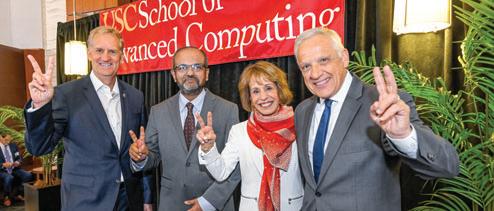
The new school will act as a nexus for advanced computing research and education across the university.
USC President Carol Folt launched the university’s first new school in more than a decade: the USC School of Advanced Computing, a cornerstone of her $1 billion
advanced computing initiative. The school seeks to educate all students, regardless of their major, in the ethical use of computing technology as part of the president’s Frontiers of Computing initiative.
Gaurav Sukhatme — a professor of computer science and electrical and computer engineering, and executive vice dean of the USC Viterbi School of Engineering — was appointed by Folt as the school’s inaugural director.
Rooted in an interdisciplinary approach, the School of Advanced Computing, a unit
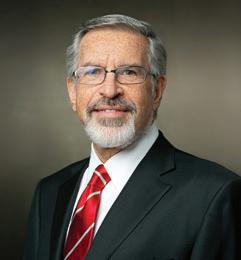
The Leonard D. Schaeffer Institute for Public Policy & Government Service is the first major research and education facility to be headquartered at the USC Capital Campus in Washington, D.C., which Folt opened in Dupont Circle last spring. LANCE IGNON AND JENESSE MILLER
of USC Viterbi, will serve as the hub for advanced computing research and education at USC. Here, engineers, scientists and professionals — from disciplines spanning the arts and humanities, business, health, sustainability and other areas — will harness the power of advanced computing to tackle society’s most pressing issues, from climate change to public health, with ethics at the core. Students from all USC schools will be able to take classes there.
The school is the keystone of the president’s USC Frontiers of Computing “moonshot,” a more than $1 billion initiative that supports ethical advancement in areas such as artificial intelligence, robotics and quantum computing. The initiative was envisioned by Folt, who jump-started the effort with a university gift of $260 million from the Lord Foundation of California. This was aimed at advancing and expanding computing research and education across the university in a strategic, thoughtful way to transform USC’s future. In a letter announcing Sukhatme’s appointment, Folt said the initiative allows the Lord gift to have “a long-lasting impact and to be game-changing for our students and faculty.” CAITLIN DAWSON
USC researchers analyzed millions of tweets to shed light on a new dimension of K-pop’s influence: public health.
BY RANIA SOETIRTO
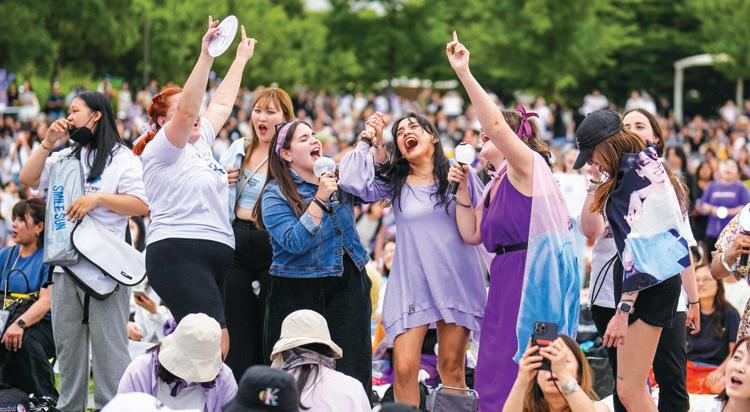
A recent study by USC researchers sheds light on a new dimension of influence by South Korean pop music, or K-pop: public health. The study, published in the journal Online Social Networks and Media, explores how fans of K-pop group BTS helped COVID-19 public health messages go viral on Twitter, now known as X.
According to their research, public health-related tweets that leveraged K-pop stars generated 111 times more online responses than those that did not. In addition, the inclusion of K-pop hashtags on Twitter reached regions traditionally underserved by Western public health organizations, including South America, Central America and Southeast Asia.
“Entertainers can be a serious force in mobilizing impactful social change,” lead author Herbert Chang says. Chang completed the study as a doctoral candidate in communication at the USC Annenberg School for Communication and Journalism, with his advisor Emilio Ferrara, a professor of computer science and communication at the USC Viterbi School of Engineering and USC Annenberg, and USC Annenberg communication doctoral candidate Becky Pham.
On Aug. 21, 2020, World Health Organization Director-General Tedros Adhanom Ghebreyesus tweeted an unprecedented public health message: He thanked BTS
for encouraging their fans to wear a mask while congratulating the release of their single, “Dynamite.”
The tweet went viral, garnering 86,400 likes and 38,600 retweets, making it one of the most shared tweets related to mask-wearing during the COVID-19 pandemic. Researchers say the boy band’s dedicated fanbase contributed to the tweet’s viral spread.
“Since the start of the pandemic, we were struck by how the simple act of wearing a mask to prevent spreading infection became incredibly politicized and divided among different communities in the U.S.,” Pham says. “So, we embarked on this project with a simple question: Who was the strongest voice in promoting mask-wearing on Twitter?”
Introducing the USC Distinguished Leaders program, where seasoned professionals 55 and above are set up to thrive with a new sense of purpose and tackle pressing global challenges.

Leaders expand their network of fellow changemakers and spend the year learning from USC’s renowned experts and faculty.
Benefit from a hybrid of online coursework and in-person experiences on USC’s campuses.
Apply today to build community, achieve impact, and enhance your own longevity.
STORY BY Chinyere Cindy Amobi and Rachel B. Levin ILLUSTRATIONS BY Temi Coker
From that critical inflection point, Boyd helped connect USC to the thriving musical movement at its doorstep. He blazed the trail for USC scholars in every corner of the university who, like himself, study hip-hop’s historical underpinnings and cultural impact.
The creativity that burst forth from communities adjacent to USC now reverberates through arts education at the university. Today, USC’s arts schools, including the USC Kaufman School of Dance, the USC Thornton School of Music and the USC School of Cinematic Arts, are prominent incubators for innovation in hiphop movement, music and visual culture, respectively. Andre Young — better known as Dr. Dre, one of West Coast hip-hop’s foremost artists and producers — became part of the Trojan Family when he and Interscope Records co-founder Jimmy Iovine launched their school for arts, technology and innovation, the USC Jimmy Iovine and Andre Young Academy, in 2013.
Hip-hop, which turned 50 last year, has followed a similar trajectory at USC as it has in American culture: from underdog to tour de force.
SOME OF THE FOREMOST INNOVATORS IN HIP-HOP ARE PART OF THE TROJAN FAMILY. USC ARTISTS AND SCHOLARS LOOK BACK ON 50 YEARS OF THE ART FORM — AND FORWARD TO ITS FUTURE EVOLUTION.
WHEN TODD BOYD FIRST ARRIVED AT USC in the fall of 1992, an explosive cultural transformation was underway. The former hip-hop emcee and newly minted professor at the USC School of Cinematic Arts had come to the university with the goal of shaping the nascent field of hip-hop studies.
The scars from the civil unrest that had erupted that spring in neighborhoods adjacent to USC following the acquittal of four white police officers in the beating of Rodney King, a Black man, were still fresh.
“You could still see buildings that had been burnt and damaged,” Boyd says.
From those ashes, a formidable force of creativity was rising. Hip-hop artists in surrounding communities were funneling their pain into profound storytelling and shaping a new West Coast sound.


New York City, widely recognized as the birthplace of hip-hop, had been the music’s de facto epicenter since DJ Kool Herc started throwing parties in a rec room in the Bronx in August 1973. But in the late 1980s, groups like Compton-based N.W.A put South L.A. on the hip-hop map with their profane and powerful critiques of the racial politics of policing. By 1992, former N.W.A members Ice Cube and Dr. Dre had released smash albums with tracks explicitly responding to the civil unrest — and the national focus turned to USC’s backyard.
South L.A., Boyd says, became hip-hop’s “center of gravity.”
While USC was located at the nucleus of West Coast hip-hop, Boyd’s introduction of hip-hop into his curriculum was new to the university. Though Howard University, a historically Black college, already offered a course on hip-hop at the time, Boyd says many in
originally chose the university for the USC Annenberg School for Communication and Journalism’s nationally ranked communications program, her “intention and motivation” changed once she fell in love with music.
“I wanted to go to USC to be in a primary market, where artists typically get discovered,” Saweetie says. “But I quickly learned that I needed to finish my degree before trying to pursue music full time because going to school full time is a beast of its own.”
While she’s proud of the success she’s experienced in her music and business ventures, she also uses her music to remind fans of the behind-the-scenes hard work and focus it took to get her degree.
“My songs don’t necessarily show my college girl side, so I wanted to shout out my education because that’s played a big role in my success,” Saweetie says. “It has helped me become a critical thinker and has also developed my emotional intelligence.”
d. Sabela grimes
academia then regarded rap music as unworthy of study. It was considered a disposable fad at best and a threatening cultural force at worst.
Today, that script has been utterly flipped. Boyd (also known as the Notorious PhD) is now nationally recognized as one of the pioneers of hip-hop studies and a sought-after media commentator on the subject. His most recent book — Rapper’s Deluxe: How Hip Hop Made the World, published in February — chronicles the genre’s breathtaking rise over its 50-year history.
“Hip-hop is a cultural movement that has traveled this really interesting journey from being marginalized and ignored and dismissed and ridiculed, to helping to elect a president, influencing the way people speak and making connections to elite spaces, such as the world of contemporary art,” Boyd notes.
In every realm where hip-hop has made its mark on American culture — from music, dance and film to entrepreneurship and scholarship — you’ll find USC faculty, students and alumni who have played leading roles in elevating and amplifying it on the national and international stage.
“See, I went to USC. And got my college degree.” — Saweetie, “ICY GRL” Saweetie (born Diamanté Harper) ’16, is among the powerhouse hip-hop recording artists who chose to pursue their degrees at USC before their careers kicked into high gear. While Saweetie says she
Saweetie has followed in the footsteps of other notable Trojans who found success in hip-hop. In 1987, Young M.C. (Marvin Young ’89) was a junior in economics at the USC Dornsife College of Letters, Arts and Sciences when he signed the record deal that led to his 1989 album, Stone Cold Rhymin’, and its breakout single, “Bust a Move.”
Likewise, before he became a global R&B star, singer-songwriter Aloe Blacc (Egbert Nathaniel Dawkins III ’01) studied linguistics and psychology at USC Dornsife. The Renaissance and Trustee Scholar got his start in hip-hop as one half of the underground rap duo Emanon.
Though none of these superstars majored in music, USC Thornton is a magnet for up-and-coming hip-hop talent. Jason King, dean of USC Thornton, is a leading hip-hop scholar and music critic with interest in augmenting the school’s hip-hop curriculum. At New York University, where he previously served as chair of the Clive Davis Institute of Recorded Music, King helped pioneer first-oftheir-kind courses in the art of emceeing.
“I want to bring that same energy and that lens to USC Thornton in terms of training musicians in the context of excellence,” King says. “I would like for hip-hop to be taken as seriously as we take classical music or jazz music.”
He notes that USC Thornton has long offered a course in hiphop music and culture, which is currently taught by musicologist Sean Nye, associate professor of practice. Many USC Thornton alumni have gone on to significant careers in hip-hop composition
and music production. The school’s music industry major has been a launching pad for alumni working at top hip-hop record labels and in artist management, including Keaton Smith ’16 and Isa Klar ’23 of Top Dawg Entertainment, an independent label that has Grammy Award-winning artist SZA on its roster.
“But we don’t have a stand-alone hip-hop performance curriculum,” King says. “And most universities don’t. That’s one of the things that I’m really looking forward to helping build out and grow at the school.”
King believes that a background in hip-hop is important for all music students, regardless of their genre of interest. “Students studying any aspect of what it means to be a musician in the 21st century have to contend with hip-hop,” King adds, citing hip-hop’s commercial and critical importance.
USC Annenberg alum Heran Mamo ’19 recalls taking Nye’s hiphop music and culture class during her time at USC and working on contemporary assignments such as having students write about the impact of the Black Panther movie soundtrack, which includes music scored by USC Thornton graduate Ludwig Göransson ’08. “It was so dope that I was able to take a whole class dedicated to a genre that I still report on,” Mamo says. “I learned not only about the origins of the genre, but also how it permeated popular culture.”
Today, Mamo covers hip-hop, R&B, Afrobeats and popular culture as a Billboard reporter. She’s profiled some of the biggest artists dominating the airwaves, including cover stories featuring The Weeknd, Ice Spice and Burna Boy.
“What I really love about hip-hop especially is that it tells a story,” Mamo says. “Whether it’s racial injustice, police brutality, gentrification or crime, even the production [of the music] lends to the storytelling of what Black people are experiencing.”
At USC Kaufman, hip-hop is so foundational to the core curriculum that all Bachelor of Fine Arts students take hip-hop dance classes for four years — not just those focusing their studies on hip-hop. And the school’s minor in hip-hop, street and social dance forms is open to all undergraduates, regardless of dance experience.
“At USC Kaufman, we believe everyone has something to contribute to the evolution of hip-hop as an art form,” says Julia Ritter, dean of USC Kaufman.
Many of the hip-hop dance styles that students learn — breaking, locking, popping, house, whacking and krumping — were literally conceived on street corners. They morphed as they gained global popularity and were polished for consumption in dance studios far removed from the communities of color where they originated.
When USC Kaufman faculty were designing the hip-hop curriculum in 2014 — a year before the school opened its doors to students — their guiding question was, “How can we honor, uplift and celebrate Black culture, which is at the core of hip-hop?” says d. Sabela grimes, associate professor of practice.
grimes developed a system of movement called “Funkamental MediKinetics” that steeps students in the rich history of Black vernacular dance practices that preceded and influenced hip-hop. He and his colleagues also introduced opportunities for students to connect with the wellspring of creativity in the neighborhoods adjacent to USC.
The biennial Cypher Summit — which is organized by Tiffany Bong, assistant professor of practice, and celebrates women in hiphop — is one of the many USC Kaufman events that gather community-based artists on campus.
“Women have been innovators, leaders, organizers, pioneers and creatives of hip-hop dance culture since the beginning,” Bong notes. “It’s important to recognize that because most of the time they have been taken out of the story, or less featured or highlighted.”
Jakevis Thomason ’20 has worked with some of hip-hop’s top female recording artists. He recently toured with R&B/hip-hop musician Kali Uchis and contributed choreography to Beyoncé’s 2023 Renaissance tour — an opportunity that came about in a surprising way.
In 2021, Thomason choreographed a short dance film set to Beyoncé’s song “Black Parade.” After filming it at the top level of the USC Shrine Parking Structure, he posted it on YouTube — and it went viral. Beyoncé’s team later reached out to see if Thomason


could teach his “Black Parade” choreography to her dancers so they could perform it on the tour.
“I freaked out,”Thomason says. “For her to see it was one thing, but for her to actually love it and want to use it ... it was a dream come true.”
Thomason believes his training in hip-hop foundations has helped him stand out from the competitive pack in the commercial dance industry. “I feel like going back and understanding where things come from ... can help you get to places you didn’t know were possible,” he says.
Bong says that USC Kaufman’s ability to ground students in local community practices and simultaneously propel them to global stages puts it at the forefront of new territory. “We are blessed with the opportunity and capability of being at the front lines every day to envision and shape where hip-hop and academia merge, and what can be birthed from it,” she says.
The School of Cinematic Arts has produced countless visionaries in film, television and new media, but the early ’90s ushered in a new era for Black filmmaking and storytelling that realistically depicted Black American life in a way never seen before.
Among the Trojan visionaries who used the different elements of hip-hop to create powerful portrayals of the Black experience in South L.A. was L.A. native John Singleton ’90. As a newly minted USC alum, he wrote and directed the iconic 1991 film Boyz N the Hood, which was released mere months after the police beating of Rodney King. The film touched on many of the same themes that West Coast rappers such as N.W.A were shedding light on, including gang culture and police brutality, and its soundtrack featured leading hip-hop artists of the era, including 2 Live Crew, Too Short and Ice Cube — who also portrayed one of the film’s main characters.
“While not a hip-hop practitioner via music, in many ways hiphop is a lens through which Singleton expressed himself, through visual culture and cinema,” says Taj Frazier, an associate professor of communication at USC Annenberg. Although some critics complained that the film glorified gang culture, it was overall a critical and financial success. The late Singleton would go on to direct many
popular films on the realities of Black community life — featuring major hip-hop artists — including Poetic Justice and Baby Boy. Rick Famuyiwa ’96 directed The Wood (1999), which stood out for its depiction of the Black middle class — a group the Inglewood native felt was not often portrayed amid stereotypes about “the hood.” Boyd collaborated as a writer and producer with his former student Famuyiwa: “It was meaningful to me because it had the mentoring aspect,” Boyd says. “I was trying to help create people who could work in the culture while doing that myself.” The Wood soundtrack is, of course, a who’s who of late-’90s hip-hop acts, including OutKast, DMX and Blackstreet. Famuyiwa — who double majored in cinema/television production and critical studies at the School of Cinematic Arts — has continued to use hip-hop as a powerful backdrop as he’s centered the lives of the Black middle class of his community in subsequent popular films, including Brown Sugar and Dope
Learning to be a critical thinker at USC has helped Saweetie become not just a lauded entertainer with two Grammy Award nominations and the NAACP Image Award for Outstanding New Artist; her education also helped her develop entrepreneurial skills.
Saweetie started the Icy Baby Foundation to foster youth entrepreneurship, and has had partnerships with multiple brands including McDonald’s, MAC Cosmetics and Champion.
Among her achievements is one her music fans might not expect: a Distinguished Speaker Award from the USC Marshall School of Business. Since graduating from USC in 2016, Saweetie has returned as a guest lecturer at USC Marshall, where as a student she took “Business for Non-Majors,” a course taught by Albert Napoli, senior lecturer of clinical entrepreneurship. Napoli’s mentorship turned out to be pivotal to Saweetie’s leap into the music industry.
During Saweetie’s senior year, Napoli, who knew of her desire to become an artist and entrepreneur, spotted her at a career fair where she was meeting potential corporate employers. Napoli pulled her aside and said, “What are you doing here? This is not you. You’re not going to be happy.”
Taj Frazier
His guidance helped her decide to pursue music full force. “I am so grateful that, although I was going to such a prestigious university, my professor saw my hunger and passion to pursue something that you can’t get a degree for and supported that,” Saweetie says.
Returning to USC as a guest lecturer is one way she pays that mentorship forward. “It’s imperative that I go back and show the students that someone who looks like them was able to go out there and achieve their dreams,” she says. “I love going back to the students, and I love answering their questions, and I love serving them in any way that I can because I know that learning from someone who was once in their position can play a big part in someone’s journey.”
Saweetie’s successful business partnerships are an example of how prestige brands, many of which shunned hip-hop in its earlier days, now clamor to align themselves with the culture. Hip-hop credibility also gives artists a potent platform for their own business endeavors.
“Hip-hop has transformed marketing culture, has transformed brand culture,” USC Vice Provost for the Arts Josh Kun says. “It’s transformed the way we think about business and entrepreneurship.”
Kun points to the success of Beats by Dre — the brand of head-
about Afro-Diasporic expression, vernacular and cultural forms and who bring in different approaches, backgrounds and philosophies in terms of how we teach about hip-hop, how we live it, how we experience it and how it shapes our own evolving consciousness.”
Frazier’s newest book, KAOS Theory: The Afrokosmic Ark of Ben Caldwell, explores the long-standing KAOS Network located in the Leimert Park neighborhood of Los Angeles and highlights how generations in South L.A. have passed down “the same kind of creative practice of experimentalism, innovation, not abiding by boundaries and rule breaking” that are the foundation of hip-hop.
He describes L.A. hip-hop as a manifestation of a community of villages with a shared history of colonialism, white supremacy and economic hardship that “bump and blur” against each other, passing down a kind of ancestral “education” that happens outside of the classroom, at kitchen tables, in cars, at bus stops, at reunions and other communal spaces. Iconic emblems of early L.A. hip-hop — including Soul Train, L.A. youth clubs, the pop-and-lock and breakdancing scene and lowrider car culture — embody this in how they drew in people from different races and walks of life.
phones, earphones and speakers founded by Young and Iovine in 2006 — as one example of a company whose ascendancy is inextricable from hip-hop celebrity. Its success, in turn, laid the groundwork for the founding of the USC Iovine and Young Academy.
“We have this pioneering academy dedicated to startup culture, entrepreneurship and interdisciplinary technological thinking that is literally impossible without hip-hop,” Kun says. “[Beats by Dre’s] platform doesn’t happen without hip-hop, doesn’t happen without Dr. Dre, doesn’t happen without N.W.A. And it all goes back to South Los Angeles.”
By the time Kun came to USC in 2005, universities around the country had already embraced hip-hop as a critical lens through which to view, analyze and dissect societal structures.
Kun — an L.A. native whose research interests include Mexican and Chicano hip-hop, which was rising in prominence in the late ’90s and early 2000s — frequently uses the crossfader as a metaphor for how cultural exchange and creation are at the heart of hip-hop’s power. A well-known cultural historian, author, curator and music critic, Kun has written and edited work on the history and politics of cultural connection, including Audiotopia: Music, Race and America
“When we look at hip-hop at the 50-year mark, it is a seismic cultural shift,” Kun says. “With hip-hop culture, where the language of the world went from linear storytelling by a singular artist to collage culture, creating a montage to borrowing and appropriating little bits of culture and ideas from here and there, putting things together into a new narrative and creating a new mix — that’s all because of hip-hop.”
USC faculty incorporating hip-hop into their different disciplines embody this concept: “This is definitely an exciting phase in terms of hip-hop scholarship at USC,” says Frazier. “We have so many unique scholars who teach about hip-hop, but even more broadly, who teach
That environment also reflects the exact kind of learning and communal scholarship that Frazier wants to inspire in his classes on campus. His courses on communication and culture focus on the poetic aspects of hip-hop, and how the genre’s different elements, including lyricism, dance and graffiti, enable listeners — especially those from the Black community — to cultivate a sense of self and awareness of the world.
Some USC faculty extend students’ worldly awareness by exploring hip-hop's impact in a global context. Edwin Hill, a USC Dornsife associate professor of French and Italian and American studies and ethnicity, examines hip-hop as a means of cultural exchange. Through courses such as “Black Music and the Political Imagination” and his Maymester course “Hip-Hop Circles Around the World,” Hill’s pedagogy transports students through space and time to look at how forces such as colonialism have shaped the development of the genre globally.
But as important as the work of scholars has been to the evolution of the culture, hip-hop has always been a youth movement. Across USC, students themselves are bringing their evolving takes on hiphop into the classroom and helping to shape the genre’s development.
“One of the privileges and benefits of us getting to work with students that are in this season of life is that we get a chance to experience how they perceive and participate in a very contemporary understanding of hip-hop,” grimes says.
“In many ways, there’s a lot that we can learn from our students,” says Frazier, who notes that USC is a place where students are encouraged to bring their rich cultural histories to bear on their hip-hop studies. “Those arenas of culture, professional life and social life that matter to them — all that stuff that they’ve gotten from family and elders and those around them — they’re not told to leave that at home when they come here.”
Like hip-hop music itself, they’re “sampling” from the past to create the future.

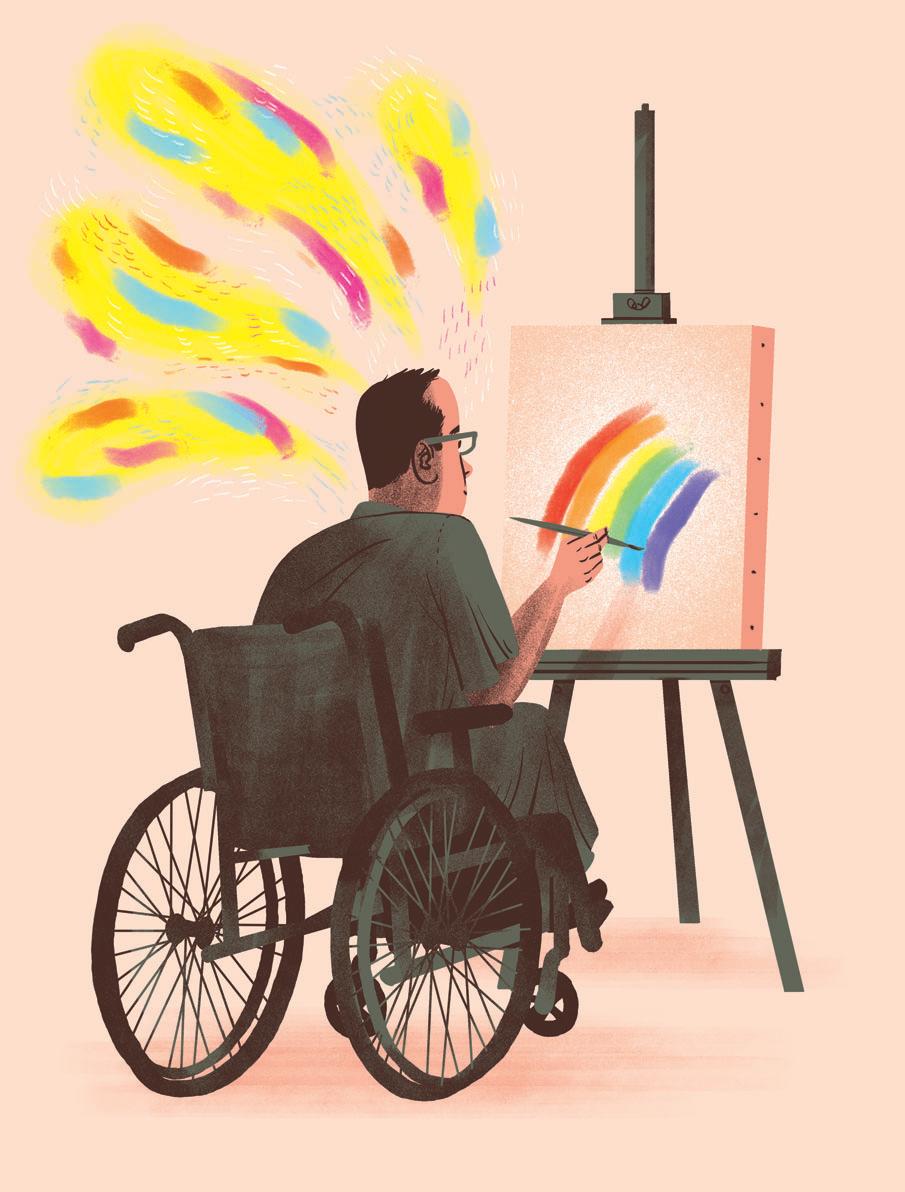
A
vibrant collection of USC programs infuses arts activities into health care to soften the hospital setting, support patients’ recovery and lift their spirits.
BY RACHEL B. LEVIN • ILLUSTRATIONS BY PAUL BLOW
Inthe USC-Verdugo Hills Hospital (USC-VHH) Breast Healthcare Center, an exhibit of oil paintings adorns the walls next to the 3D mammography machine. Each artwork depicts a stunning natural scene: Wildflower-studded cliffs framing an azure sea. A footbridge arching over a tranquil pond. Glass vases brimming with irises and sunflowers.
A cancer screening room may seem an unlikely venue for a gallery display. But the artist, Marijane Hebert, sought the opportunity to show her work here. A two-time breast cancer survivor and patient of the USC-VHH Breast Healthcare Center, Hebert knows firsthand how nerve-wracking it can be to undergo breast cancer screening — and how art can be a refuge during diagnosis and treatment.
“When you hear the word ‘cancer,’ it’s very frightening,” says Hebert, 85, a La Cañada Flintridge resident who has exhibited in galleries in the United States and Europe. “I just thought that art would be fabulous to have in the Breast Healthcare Center to help create a calming atmosphere.”
Hebert’s exhibit was made possible by the USC-VHH Healing Arts Program, which mounts permanent and rotating exhibits by local artists in the hospital’s hallways and treatment spaces. Supported by the Sue and Steve Wilder Healing Arts Endowment, the program also allows hospitalized patients to select a work of their choice from a roving “Art Cart” to keep in their room during their stay and to take home.
“We focus on fine art reflecting positive images of nature and familiar scenery,” says Julie Shadpa, an art therapist by training who is co-chair of the Healing Arts Program and director of donor
programs and strategic outreach for the USC-VHH Foundation. “Research has indicated that such imagery lowers stress and distracts from pain. ... It gives people a sense of place and connection in the hospital environment, which can be stressful and unfamiliar.”
Art has been used as an adjunct to medical treatment since ancient times. But in the past few decades, a growing body of research has confirmed that viewing and creating art can benefit patients’ physical and mental well-being. The Healing Arts Program is among a robust collection of USC programs that combines the arts with medicine in creative and evidence-based ways to comfort patients and support their healing.
At the Institute for Arts in Medicine (I_AM) at the USC Norris Comprehensive Cancer Center, a wide range of expressive arts programming aims to improve clinical outcomes for patients.
In the Creative Corner, a cheerful arts studio in the hospital, patients can try their hand at fun projects like painting rocks with inspirational sayings or personalizing a hospital wristband. On Zoom, they can join poetry-writing workshops. From their hospital rooms, they can write, sing and record an original song with the help of a songwriter. In the Rare Book Room at the USC Norris Medical Library, they can plan a body painting session with artist-in-residence Savannah Mohacsi, who draws inspiration from archaic medical illustrations. She later turns the region of the body that is ailing the patient into a creative canvas.
“Creative interventions such as music, poetry and painting can significantly decrease anxiety, depression and a lot of the negative psychological aspects associated with cancer and its treatment,” says Jacek Pinski, associate professor of medicine in the division of medical oncology at USC Norris and executive clinical director of I_AM. The immune system, which plays a critical role in fighting cancer, “gets boosted by these interventions,” he adds.
Patients can also don virtual reality (VR) goggles to engage with artistic renderings of natural settings like waterfalls and beaches. Pinski and the I_AM team are currently conducting a clinical trial evaluating the impact of these VR experiences on pain and anxiety during painful bone marrow biopsies.
Yet data doesn’t easily capture some of the most impactful aspects of I_AM’s arts programming. The activities allow patients to reflect on their experiences with illness, integrate them into their larger life journeys and glean wisdom that fortifies them through ongoing challenges.
“We call ourselves ‘I_AM’ for a reason: We believe that creative expression brings people closer to their true identities,” says Genevieve “Viva” Nelson ’18 (SCA), the creative director and co-founder of I_AM. “Engaging with the arts and engaging with our team allows patients to recognize their importance and their value and connect to their extraordinary capacity to be creative.”
Twice a week, children at Los Angeles General Medical Center receive a visit from specially trained USC staff. These visitors aren’t
Carolyn Meltzer, dean of the Keck School of Medicine of USC, is a leading scholar in neuroradiology. But on her website, carolynmeltzer.com, you won’t find any information about her extensive research in brain imaging. Instead, you’ll find her portfolio of fine art photography.
Meltzer, whose art has been featured in more than 50 solo and group exhibits in the United States and Europe, believes that the visuospatial skills she has cultivated through photography strongly inform her work in radiological imaging. “Having this artistic outlet makes me a more effective colleague and leader on the medicine and scientific side,” she says.
Meltzer’s experience is one example of how the arts can be a vital resource for medical practitioners. Artistic endeavors can sharpen diagnostic skills, help physicians tend to their own wellness and deepen understanding of the human condition.
“I don’t think you can be a fully compassionate doctor without having some of the skills that can only be learned in humanistic and artistic pursuits,” says Pamela Schaff, professor of clinical medical education, and family medicine, and pediatrics (educational scholar).
Schaff is the director of Keck School of Medicine’s Humanities, Ethics, Art, and Law (HEAL) Program, which has been weaving the arts into the core curriculum for medical students since its founding in 1985. The multipronged program includes art exhibits by — and discussions with — artist-patients whose artwork explores the experience of living with diseases that students learn about in their classes.
“When you’re just reading a textbook, or just even interviewing a patient, you don’t understand diseases in as fully realized a way as when you’re also seeing the artwork that has been born out of the experience,” Schaff says.
Fourth-year medical student Tejal Gala has enjoyed immersing herself in the artist-patients’ exhibits in the medical school’s Hoyt Gallery and participating in the discussions. “It’ s a wonderful reminder that patients are more than a constellation of symptoms,” she says. “When we really pay attention to their emotions and how they’re feeling, we’re tapping into the art of medicine just as much as the science.”
The HEAL Program also offers medical students the opportunity to participate in the arts through creative writing workshops and music
wearing white lab coats or surgical scrubs — they’re sporting red noses and ridiculous costumes. They play ukuleles, blow bubbles, juggle scarves and devise silly scenarios.
They’re medical clowns from USC Comic+Care, a program at the USC School of Dramatic Arts that employs comedic arts to support children grappling with illness.
Both disease symptoms and the hospital environment itself can dim children’s natural propensity for creative play. “You are given a [hospital] gown and put into a room that is completely unfamiliar to you and rather sterile,” says Zachary Steel, assistant professor of theater practice at the USC School of Dramatic Arts and director of USC Comic+Care. “We are trying to reframe the hospital visit into something with the potential for joy and play.”
The laughter that the clowns spark is medicine of its own. Research has shown that laughter can do everything from boosting immune and endocrine responses to decreasing blood pressure and feelings of despair. USC Comic+Care is currently partnering with the hospital’s pediatric oncology and hematology clinic to conduct a study on the effect of clowning on children’s pain perception and levels of stress and anxiety during blood draws.
lessons. Gala herself is a photography enthusiast who recently published Keck in Bloom, a coffee table book of photos of the varied plant life on USC’s Health Sciences Campus. She found that exploring nature with her camera was a powerful stress reliever.
“Having time to engage the arts is an important part of ... taking care of ourselves, so we can be there for our patients,” Meltzer says.
The dean hopes to bring USC’s many wellestablished arts in medicine programs under a more cohesive umbrella. She also envisions launching new interdisciplinary ventures between the Keck School of Medicine and USC’s arts schools. In February, the Department of Radiology debuted the Center for Advanced Visual Technologies in Medicine, which adapts novel applications of digital and 3D visualization techniques to patient care, education and research. The center connects creative technologies across multiple units and schools, including the USC School of Cinematic Arts.
Arts collaboration “is a strategic priority for the Keck School of Medicine because it creates unity and supports our practitioners and our patients,” Meltzer says. RACHEL B. LEVIN
Steel is also training the next generation of medical clowns. He teaches introductory and advanced medical clowning, the latter offering USC undergraduates the opportunity to do some clowning of their own with the children at Los Angeles General Medical Center.
“It’s beautiful when you hear the children’s laughter,” Steel says. “It’s a recognition of, ‘I still have the capacity for joy. I can still play. I’m still a kid.’”
Older adults, too, can benefit from the lightheartedness that arts activities inspire. Dance is one example: The art of movement offers neurological, social and emotional benefits to those struggling with neurodegenerative diseases such as Parkinson’s disease.
“Dance can trick our brains into working better,” says Patrick Corbin, associate professor of practice at the USC Kaufman School of Dance. Research has shown that Parkinson’s patients who participate
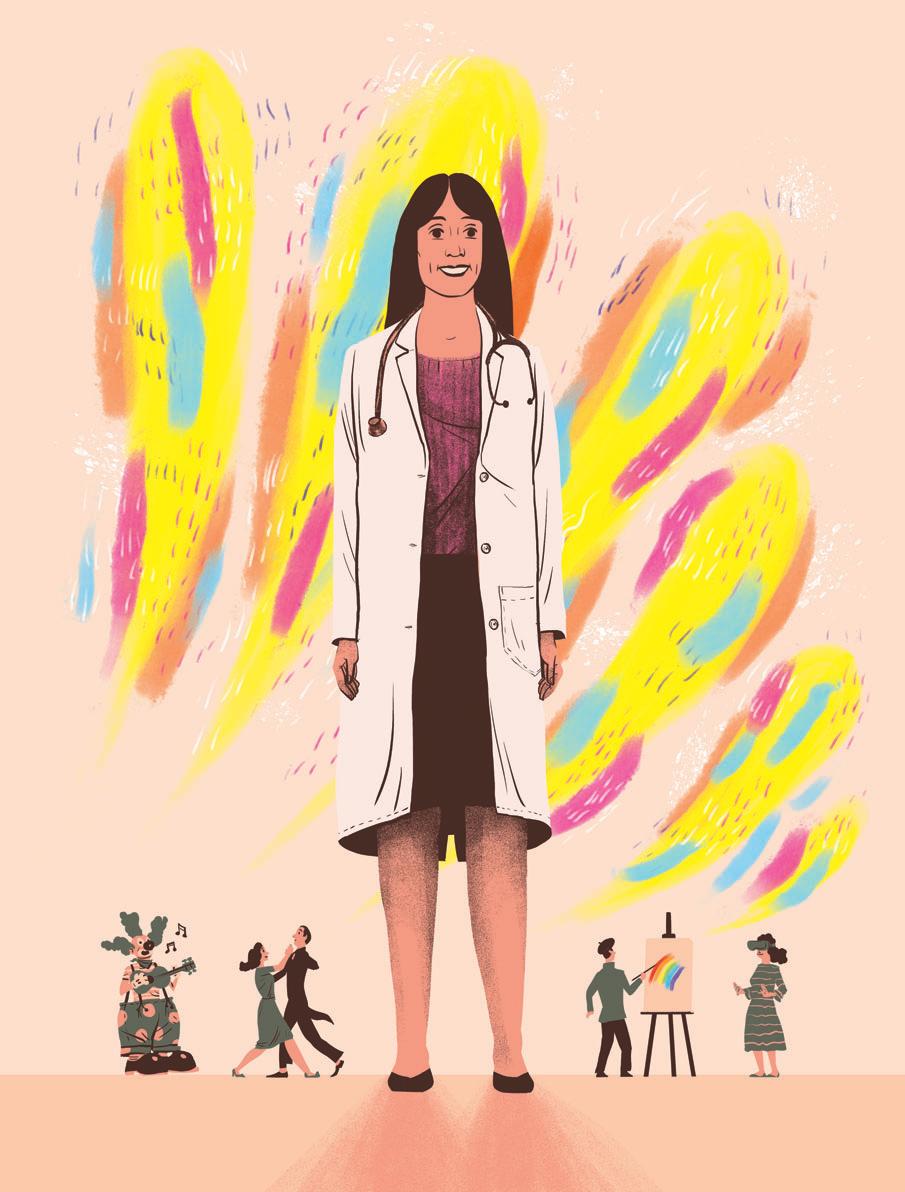
“Creative interventions such as music, poetry and painting can significantly decrease anxiety, depression and a lot of the negative psychological aspects associated with cancer and its treatment.”
– JACEK PINSKI
in dance have improved speech, fewer tremors, better balance, decreased rigidity and slower disease progression compared to those who do not.
Corbin teaches “Dance and Health: Dance and Parkinson’s,” an undergraduate course that combines movement instruction with guest lectures from experts in a variety of health science disciplines, including the Department of Neurology at the Keck School of Medicine of USC, the USC Mrs. T.H. Chan Division of Occupational Science and Occupational Therapy at the Herman Ostrow School of Dentistry of USC, and the USC Leonard Davis School of Gerontology.
Students put that knowledge into action through fieldwork in the community. They observe and participate in dance classes for Parkinson’s patients taught at Lineage Performing Arts Center in Pasadena, Calif., a partner of the Keck School of Medicine. For their final exam, students teach a segment of the Lineage class on their own.
The “Dance and Health: Dance and Parkinson’s” class is part of a series of adaptive dance classes that Corbin conceived. In fall 2023, his class focused on Down syndrome and brought dancers from Free 2 Be Me Dance — an organization that serves people with Down syndrome — to USC Kaufman for instruction. Another course for children with autism spectrum disorders is in the works.
Corbin praises his collaborators in USC’s health sciences schools who are helping him illuminate the power of dance to influence the well-being of marginalized communities.
“These wonderful doctors are really seeing the scientific value of the connection between the arts and sciences,” Corbin
says. “I think we’re just at the beginning of creating a world where better lives are accessible to people who may have been overlooked before.”
Building new partnerships between USC’s health sciences and arts schools is a priority for Josh Kun, vice provost for the arts. In March, he and Michele Kipke, associate vice president for strategic health alliances at the Keck School of Medicine of USC, led a daylong retreat for deans and faculty to spark new research collaborations between the arts and health sciences. Their efforts reflect USC President Carol Folt’s “moonshot” on transforming health sciences, which seeks to expand health sciences work across the university.
Kun notes that among their many benefits, USC’s varied arts in medicine programs provide patients an antidote to the isolation of illness.
“When we hear a song, when we watch a dance performance, when we watch a film, when we look at a painting or a sculpture, one of the things that can happen is you realize you are not alone,” Kun says. “Somebody else’s experience touches your own life.”
Hebert — who, in addition to her permanent exhibit in the USCVHH Breast Healthcare Center, has an exhibit on display in the main USC-VHH building through June — echoes his sentiments.
“When we go through illness, we have to give back and share with others, so they can know that you do get through these things,” she says. “Life does move forward.”
The largest river restoration and dam removal project in U.S. history is underway along the Klamath River, which runs through Oregon and California. Could the river’s restoration ensure that salmon, trout, birds and other species will thrive?
BY NINA RAFFIO ILLUSTRATIONS BY MATT TWOMBLY
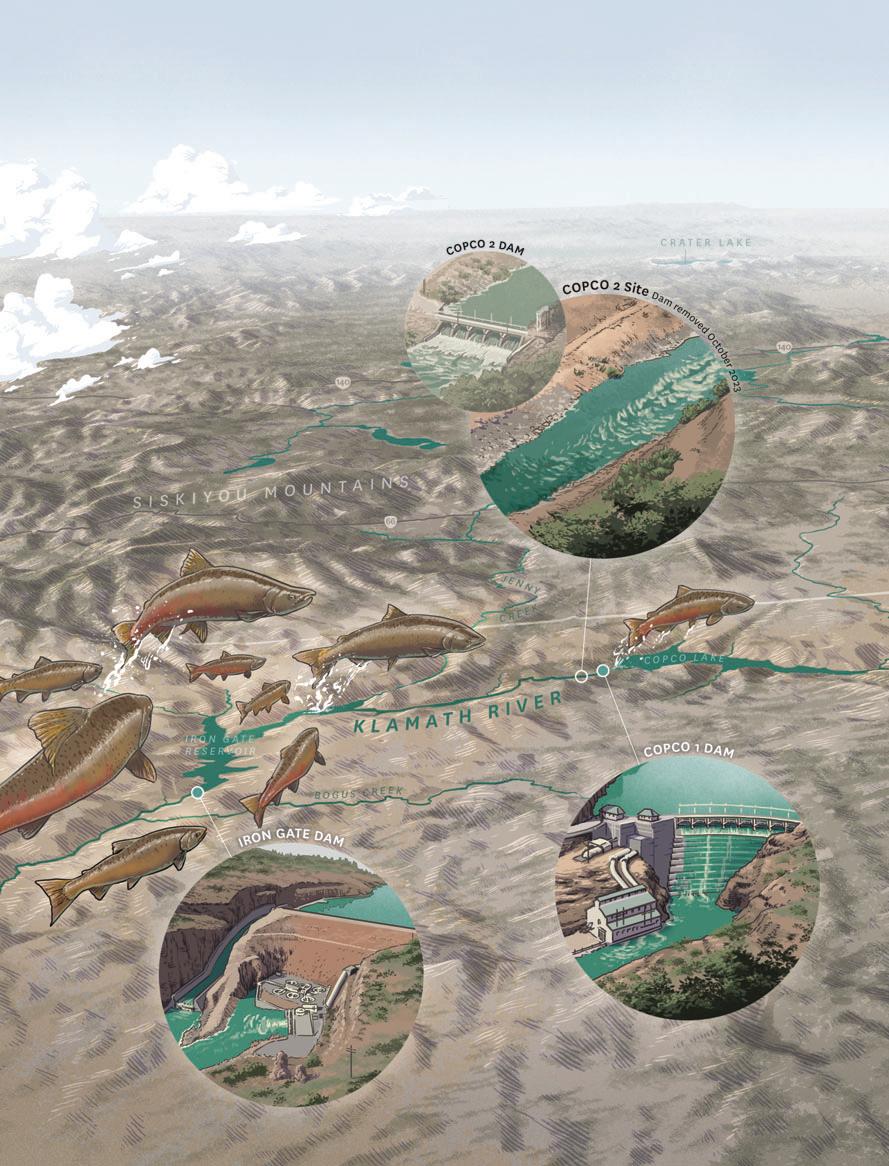
The Klamath restoration project aims to unlock over 400 miles of essential spawning habitats for local wildlife.

In 2002, a combination of warm temperatures, low flows and fish bottlenecking caused a bacterial outbreak that killed more than 34,000 salmon.

Experts explain that aging dams have always been marginally profitable and generated minimal hydroelectric power.

The $500 million project comes after decades of litigation involving various stakeholders who depend on the river and its resources.

A 2016 agreement aimed to manage water resources in the Klamath Basin by removing four dams — J.C. Boyle, Copco


The federal government authorized construction of the Klamath Project in 1905 to bring irrigation water, hydroelectric dams and storage reservoirs to the mostly arid Upper Basin and draw white settlers to the region.

The Klamath restoration project aims to unlock more than 400 miles of essential spawning habitats for local wildlife.

The Klamath River holds personhood status under Yurok tribal law, which entitles it to the same legal rights as humans.

The “upside-down river,” as the Klamath is known, spans 263 miles and ranks among the largest watersheds in the American West.

The largest river restoration project in U.S. history is underway along the Klamath River. One aging hydroelectric dam along the river’s Lower Basin was decommissioned last fall, and three more are being removed this year.
The $500 million Klamath Project marks a significant reversal in U.S. water management history, restoring the river to its natural flow and unlocking over 400 miles of essential spawning habitats for local wildlife and fish, including several species of endangered salmon.
The river’s renaissance follows decades of litigation involving an array of stakeholders: local tribes, communities, farmers, government agencies and energy companies — all of whom depend on the river and its resources.
Experts say that years of climate-induced drought have magnified tensions over water scarcity in the Klamath Basin. That means less water available for everyone — including fish and wildlife.
“In dry years, there hasn’t been enough water for everything: the salmon, the tribes, the ranchers and the farmers,” says water law expert Robin Craig, the Robert C. Packard Trustee Chair in Law at the USC Gould School of Law. Craig researched climate resilience in the Klamath River as part of an National Science Foundationfunded group studying adaptive governance of U.S. water systems. “You can’t have agriculture and ranching without a reliable water supply because it’s too dry,” she adds. “But you also can’t have the fish with the dams that help make the water supply reliable. There’s tension there that is hard to escape.”
The Klamath spans 263 miles and ranks among the largest watersheds in the American West. Nicknamed the “upside-down river” for its unusual origin in arid lands, the Klamath begins in Eastern Oregon, where it pools into large lakes, then flows slowly over flat terrain, winding into Northern California. From there, the river grows

“When














Mitul Luhar, USC Viterbi
wilder, traversing through rugged mountains and dense temperate forests before spilling into the Pacific Ocean.
This peculiar geography has rendered this region particularly vulnerable to a multitude of challenges now amplified by climate change.
“For a long time, we’ve tried to control rivers to alleviate flooding, ensure access to water supply, and in the case of the Klamath dams, to provide electricity,” says Mitul Luhar, the Henry Salvatori Early Career Chair and associate professor of aerospace and mechanical engineering and civil and environmental engineering at the USC Viterbi School of Engineering. “When we dam up rivers, we substantially alter natural processes, both in terms of the flow of water

and the flow of sediment which help maintain the landscape and have significant impacts on water quality.”
For more than 100 years, competing interests have been as sharply divided as the canyon walls split by the wild Klamath. Conservationists and tribes, businesses and farmers were often at odds amid a convoluted patchwork of water rights, court decisions and federal wildlife protections.
In 1905, with the enthusiastic support of then-President Theodore Roosevelt, the U.S. government authorized construction of the Klamath Project to bring irrigation water, hydroelectric dams and storage reservoirs to the Upper Basin to support white settlers. Wetlands that had been home to millions of fish and migratory waterbirds over the centuries were drained and disrupted as the government launched into nearly 50 years of construction.
The U.S. Bureau of Reclamation continues to manage the Klamath Project and its extensive canals that service approximately 240,000 acres of land for crops such as potatoes, primarily in south-central Oregon.
Since the early 1990s, federal mandates to revive fish populations protected by the Endangered Species Act have forced water allocation cuts, sparking major legal battles over water rights.
Extreme drought in 2001 prompted the Bureau of Reclamation to cut water allocations for Klamath Project irrigators and conserve Upper Klamath Lake to protect habitats of endangered suckerfish. Farmers and ranchers united in protest. The next year, they were granted greater water allotments.
The consequences were astounding. The water reallocation to farms and ranches in 2002 coincided with a toxic combination of warm temperatures, low flows and fish bottlenecking that gave rise to a bacterial outbreak. More than 34,000 salmon died, according to the California State Water Resources Control Board, though by some counts the toll may have exceeded 70,000. The massive die-off — among the worst recorded in the American West — spurred local tribes to advocate for the removal of the dams.
Who Owns the Klamath?
The tribes’ lives have been intertwined with the river for generations dating back at least 7,000 years by some estimates.
Once the third-largest salmon run on the West Coast before it was dammed, the Klamath River, its fish and wildlife have long been integral to the cultural and spiritual identity of Native American tribes in the region. Tribes such as the Yurok, Karuk, Hoopa, Shasta and Klamath nurtured the surrounding land and river, relying on it for sustenance. The river is so sacred to the Yurok that it is like kin. Under their tribal laws, it has the same legal rights as humans, Craig says.
Senior water rights should have been assured for the tribes, due to their long-standing presence in the Klamath River Basin and the Winters Doctrine, a legal principle established by the U.S. Supreme Court in the 1908 case of Winters v. United States. For years though, U.S. courts awarded seniority to white farmers and ranchers, Craig says.
Seventy-five years later, in 1983, the courts finally ruled in the tribes’ favor, granting them authority over the waterway “at least in Oregon,” Craig says. “Their water rights were determined to be extensive, dating back to time immemorial.”
Senior water rights were among the factors that led to the 2016 agreement to remove four of the dams — J.C. Boyle, Copco No. 1, Copco No. 2 and Iron Gate — from the Lower Klamath River. Another factor was timing.
The company that owned and operated them, PacifiCorp, was facing the expiration of a 50-year Federal Energy Regulatory Commission license and the prospect of a rigorous environmental review.
So, PacifiCorp made a cost-effective decision to surrender the license and decommission the aging dams, which experts said had always been marginally profitable and generated minimal hydroelectric power.
Conservationists hope the dams’ removal will rebirth the river, restoring its health and abundance. Experts note, though, that the effects of climate change, such as persistent drought, raise new challenges for the river’s management and the lives it supports.
Even so, Craig says the removal of the dams is a major victory for the tribes and conservationists who fought for the river’s release.
“If you think about it,” Craig says, “this will be the first time in over a century that salmon will be able to make it up to the Upper Klamath River. And that will be a wonderful sight to see.”


Charles Mills hoped for a different start to his career on the USC water polo team. In an exhibition match last September against Golden West College, an opposing player’s arm smashed down onto Mills’ wrist as he defended a shot. Initially, Mills says the pain wasn’t too severe. But on his way home that night, the first-year goalie fell off his bike onto that same wrist. The pain kept him up for much of the night.
“That next morning, I knew something was up,” Mills says.
He immediately visited the USC athletic trainers, who directed him to an orthopedic specialist at Keck Medicine of USC. Seth Gamradt, who also serves as director of athletic medicine at USC Student Health, gave him the news: Mills had broken the scaphoid bone in his left wrist.
Less than a month into his freshman campaign, just like that, his season was over.
“I was in complete denial,” Mills says. “I thought I had just jammed my wrist really hard — I didn’t think I’d broken it, let alone that I’d be out two months.”
Although Mills says it was a tough pill to swallow, Gamradt and his team immediately shifted the discussion to recovery.
“Dr. Gamradt and his team comforted me and told me I was going to get through this, which helped me not freak out too much,” Mills says. “I was still completely crushed, but I had complete trust in them.”
A surgery, two months in a cast and some physical therapy later, Mills made a full recovery. He credits it to the care he received from the athletic trainers and health care team in the athletic medicine program at USC Student Health, along with his surgeon Luke Nicholson and the orthopedic team at Keck Medicine of USC. In a sport rife with shoulder and hip injuries and the
occasional broken wrist, access to top-notch care is crucial.
Fortunately for Mills, his teammates and the roughly 700 other Trojan student-athletes, the athletic specialists from Keck Medicine of USC provide some of the best care in the region.
“The care here at USC is completely unmatched,” Mills says. “Everything was super organized, and there was full transparency — I trusted the process, and it worked out 100% well for me.”
His teammate Max Miller — a first-team all-American 2-meter — agrees. He credits the doctors as part of the reason Trojans can continue playing after an injury. “It’s a very comforting feeling to be able to just do my thing in my sport, and then if something ends up happening, I know they’ll find a way to fix it,” he says.
When it comes to athletics injuries, few have seen more than Gamradt and Alex Weber. As orthopedic surgeons and team doctors, they’ve been on the sidelines for championship games and witnessed some of the greatest athletes compete at the highest level.
Gamradt — lead physician for Trojan football for the past 11 years — also worked at the professional level with the NFL’s New York Giants before coming to the West Coast. He is an orthopedic surgeon with Keck Medicine of USC and director
of Athletic Medicine, a department in USC Student Health that oversees health care for student-athletes.
“It was an opportunity that I couldn’t turn down,” Gamradt says. “It’s an incredible institution, and the Trojan Family is real — anytime I’m wearing USC gear when I’m out and about, I’ll always get a ‘Fight On!’”
For the past eight years, Weber has served as a team physician for USC Athletics as part of USC Student Health and Keck Medicine
all four physicians provide orthopedic care to all 21 Trojan athletic programs.
“Sometimes it’s an 81-year-old, and sometimes it’s an 8-year-old, sometimes it’s a high school athlete hoping to be a collegiate athlete,” Weber says. “Then sometimes it’s a collegiate athlete trying to be a professional athlete, and sometimes it’s a professional athlete trying to get back to his livelihood. Ultimately, all of those scenarios fall into the same bucket of someone
“THE CARE HERE AT USC IS COMPLETELY UNMATCHED. EVERYTHING WAS SUPER ORGANIZED, AND THERE WAS FULL TRANSPARENCY."
CHARLES MILLS, USC WATER POLO
of USC, while also serving as chief of the USC Epstein Family Center for Sports Medicine at Keck Medicine of USC. In addition, he is the medical director and head team physician of the NHL’s Los Angeles Kings.
Joseph Liu and Cara Hall have been at Keck Medicine of USC for three years. Both work with the NHL’s L.A. Kings, and

high-functioning losing that function, and getting them back to doing what they love.”
The sports medicine team helps make those moments possible, whether that’s Gamradt working the sidelines of Trojan football games, Weber sitting courtside at men’s basketball games, Hall tending to the Women of Troy in a packed Galen Center or Liu treating the members of the men’s volleyball team.
“Working with the women’s basketball team has really been the best part of the job for me,” Hall says. “It’s such a small team, and we have come leaps and bounds from where we were a few years ago. Seeing them excel at what they do and traveling on the road with them and seeing them make it to March Madness last year — it’s rewarding for everyone involved.”
The team of orthopedic surgery specialists at Keck Medicine of USC are some of the most highly regarded physicians in L.A., so much so that the Kings, a $2 billion NHL team, wanted to partner with them to take care of their athletes.
“One great thing about taking care of the hockey guys is that there’s a culture in hockey that the guys want to play,” Weber says. “We do that within safe parameters — we don’t let people go back when it’s unsafe to be on the ice — but I think the culture in hockey is get fixed up so you
BY
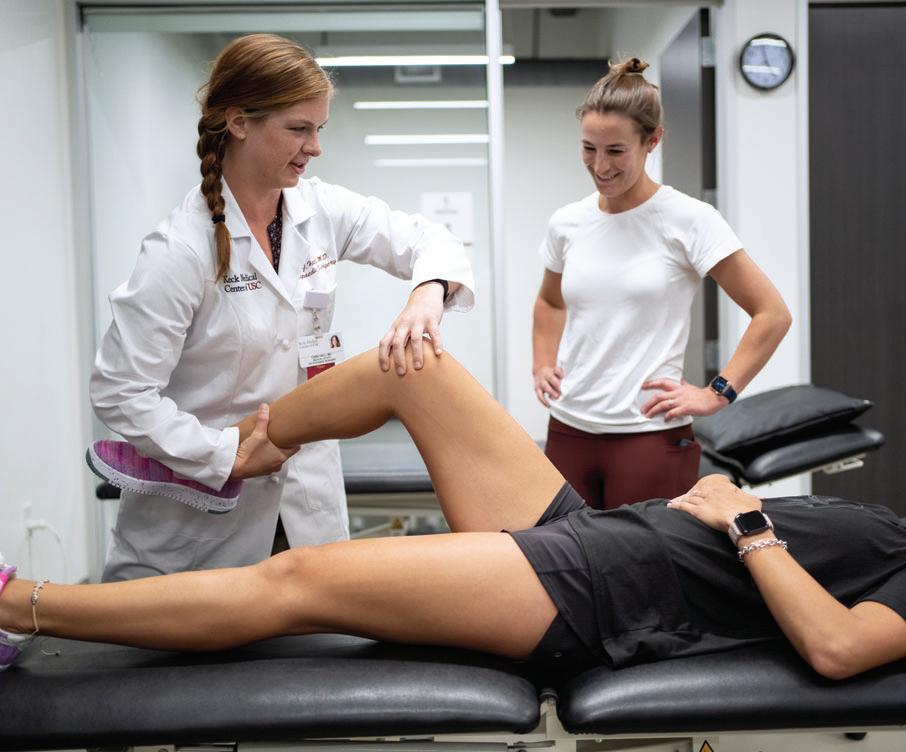
can get back out there and play hard for your teammates.”
As the team of physicians looks toward the future of their profession, they note that social media has had a significant impact on sports medicine, both good and bad.
“There are a lot of what we call ‘Twitter doctors’ who are out there speculating on the injury and how long this athlete’s going to be out. Social media has become the biggest influence on the scrutiny of athletic injuries,” Gamradt says.
For Hall, the increased attention has spotlighted her chosen profession, which she hopes will inspire the next generation of sports physicians.
“The number of students that have reached out to me just from finding my name on the [Keck Medicine] website — medical students or even undergrad students who are interested — has exceeded what I was expecting,” Hall says. “Anyone interested in physiology or kinetics and movement from a science or physical therapy perspective, I think there’s probably a growing interest compared to what it used to be, which is great to see.”
While these doctors have treated their fair share of all-stars and all-Americans, they’ve also treated plenty of weekend warriors. Aside from dealing with agents and the financial implications of a top-level athlete’s injury and recovery, they all say that the mission for treating their patients is the same.
“It’s so hard to pick my favorite part of the job because it’s so multifaceted,” Gamradt says. “I get to teach residents, medical students and fellows how to do surgery. I get to care for patients of all ages and make them better with or without surgical treatment, and then I have the added bonus of being the team physician.”
That type of attitude influences the athletes in return. Whether on the field or off, it’s nice to know everyone’s on the same team.
“I still see Dr. Gamradt and the other trainers around campus, and even with my full recovery, they’re always asking me how I’m doing and if I need anything — so, it’s not just a one-and-done deal,” Mills says. “I know that they always have my back.”

Don’t let bone or joint issues impact your ability to stay active. Meet with the best-in-class orthopaedic experts of USC Orthopaedic Surgery, part of Keck Medicine of USC.
Our specialists provide multidisciplinary, patient-centered care — from diagnosis through rehabilitation — to the LA Kings, USC athletes and you.
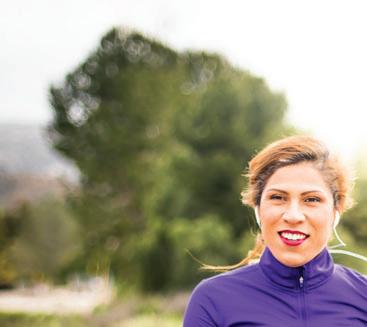

We treat all conditions, from simple to complex, including:
• Sports injuries
• Fractures
• Foot and ankle issues
• Spine and musculoskeletal conditions
• Osteoarthritis
• Hand injuries





President Carol Folt (center) led a USC delegation on a three-city tour of India in January. Apart from touting USC as a partner of choice for Indian students, businesses and government organizations, Folt also connected with Indian Trojans, many of whom are in fields such as science, pharmacy, law, the arts and gaming.
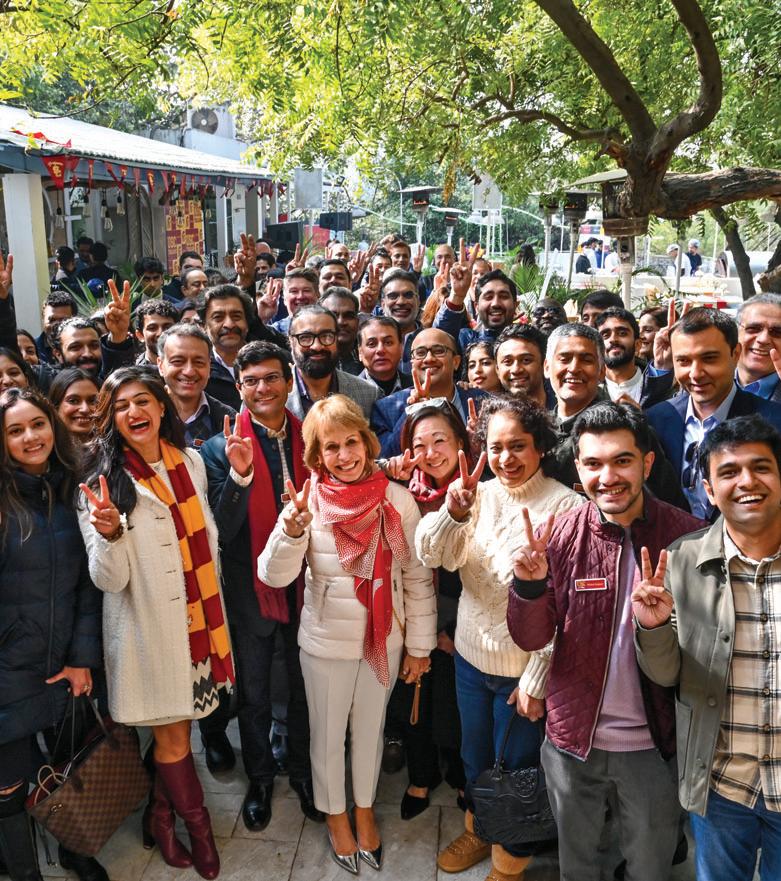
Results of the 2023 USC Alumni Survey shape our path forward.
In 2023, the USC Alumni Association (USCAA) invited all alumni who could be emailed to participate in an online survey to learn how to improve programs and services for the next century of alumni engagement. Thank you to all who participated; your feedback is essential to the work of the USCAA and how it moves forward.
Based on the survey results, the USCAA will continue to create personalized, custom experiences for alumni; promote positive stories about USC’s impact that drive alumni engagement; instill pride and enhance USC’s reputation; and encourage alumni to stay involved and support USC.
It was clear from the results that the USCAA’s role in building and maintaining Trojan Family connections is essential. With that in mind, the association will analyze the lessons learned about engaging alumni and enhance efforts to reach more Trojans, build an even stronger alumni network and create the best possible alumni experiences.
Your voice is heard, lifelong and worldwide.
WHAT DO ALUMNI THINK ABOUT THEIR TIME AT USC?
The survey asked several questions to measure how alumni feel about their experience as students.
HOW DO ALUMNI FEEL ABOUT USC?
The measurement of alumni engagement takes several factors into consideration, including values/opinions, actions of support and interest in future action.
INSTITUTIONS*
“I am proud of my association with USC.”
“I am likely to come back to campus for activities/events.”
“Alumni volunteers have a positive impact on my university.”
ratings reflect responses for other universities.
WHAT DO ALUMNI VALUE MOST FROM USC?
In short, alumni value forging Trojan Family connections and want USC to continue to provide these opportunities.
Connecting alumni with each other based upon professional interests
“My
Connecting alumni with each other where they live
Mentoring and career support for alumni
The majority of working alumni are satisfied with their current job or job status and are employed in areas related to their degree. They look to USC to continue to provide opportunities for professional connections.
WHO RESPONDED TO THE SURVEY?
Respondents were demographically similar to the overall alumni population, reflecting USC’s diverse, geographically dispersed alumni network.
465K+
LIVING DEGREED ALUMNI
*Number at the time of the survey
85% of currently employed alumni indicated their employment is related to their USC education
195K+ of working alumni reported they are looking for a change in their current job or job status 20% 76% agree that their degree remains professionally valuable to them
INVITED BY EMAIL
HOW WAS THE SURVEY CONDUCTED?
9,800 STARTED SURVEY
6,300 RATED THEIR ENGAGEMENT
7,400 COMPLETED SURVEY
4,800 PROVIDED QUALITATIVE FEEDBACK
Every USC school was represented in proportion to the number of its degreed alumni.
43%
RECEIVED FINANCIAL SUPPORT WHILE AT USC
HAVE A FAMILY MEMBER WHO ATTENDED USC
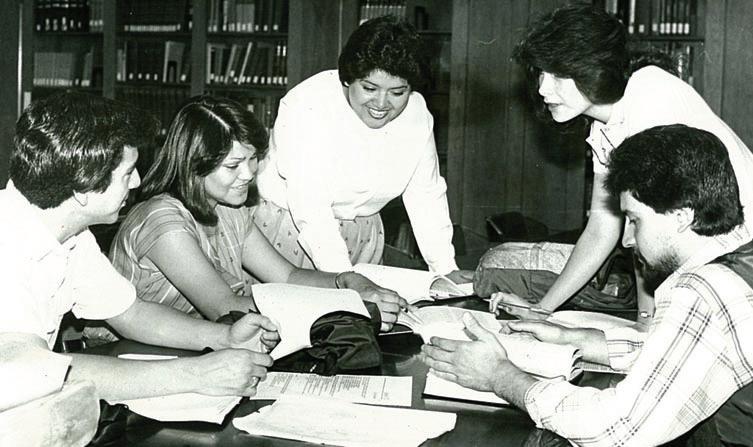
USC Latino Alumni Association marks its 50th an niversary at a time of record-setting Latino enrollment. BY
GREG HERNANDEZ
USC Trojan Marching Band drum major Jacobo Herrera was a financially strapped freshman “digging around for scholarship money” when he first connected with the USC Latino Alumni Association (USC LAA).
The USC Thornton School of Music senior ended up being awarded scholarship money from the association each of the next three years. Herrera says in addition to the financial assistance, his connection with the association has brought him mentorship and community.
“It’s really like a big family,” says Herrera, a first-generation student who grew up in San Bernardino. “All the wonderful ladies in the office, they honestly feel like my tías. I feel so comfortable with them and with my fellow scholars.”
Herrera is one of approximately 350 students who receive scholarships of $3,000 to $5,000 annually from the association, which celebrated its 50th anniversary at a scholarship
gala dinner on March 2 at the Warner Bros. Studios in Burbank.
Just over five decades ago, a group of USC alumni founded the USC Mexican American Alumni Association. (In 2011, the organization changed its name to be more inclusive.)
Raul Vargas, then head of USC’s Mexican American Programs, was one of its cofounders. He became the executive director of the first-of-its-kind association that sought to assist Latino students with the high costs of a private university and increase the Latino student population at USC.
Today, the USC LAA is the oldest and one of the largest Latino college alumni associations in the United States with approximately 5,000 members. Since its founding in 1973, the association has awarded $23.4 million in scholarship funds to 9,700 USC
students and has a $12.9 million endowment. It continues to thrive at a time when USC’s Class of 2027 set a university record by being 20% Latino.
Alumni members speak to students one on one, deliver leadership training presentations, share service and job opportunities, help with fundraising and networking, and donate gently used business attire.
“We started as a scholarship program to make sure that USC was affordable,” says Mercy Willard, the association’s executive director. “Now, we have this huge network of alumni who have helped us propel each group of students every year and have helped build alumni pride.”
The situation was far different when Michael Felix ’83, now a USC Board of Trustees
member, got accepted into USC in 1979 as a business major. There was immense joy and excitement for the first-generation college student and his proud family, who lived in nearby Pico Rivera. But then came the reality of how to pay the annual $7,000 tuition.
“I took out a lot of loans, and my parents contributed a good amount,” says Felix, who held a work-study job on campus and other part-time jobs in addition to receiving scholarship money from USC LAA.
But by his junior year, finances had become impossibly tight. Felix’s mother came to campus in tears and asked Vargas to please increase the amount of her son’s scholarship. Felix received “a significant bump” of $1,000, which made all the difference to him and his family.
Vargas retired as executive director after 33 years in 2006. His successor, Domenika Lynch, helped increase fundraising for the organization and elevated student programming. She also reached out to Felix and asked him to become involved in the association’s Corporate Advisory Council.
Felix had never forgotten how much the association had meant to him during his college journey, but he recalled that he would sometimes feel unwelcome at USC.
“I felt privileged to be there,” he says. “It was a whole new world for me, and I felt I was getting a great education, but [fellow students] were asking me how long I’d been in this country and how long I’d been speaking English. It was just a very different experience from what it is now.”
Felix, retired senior vice president of the Capital Group Companies, knew that by getting involved in the USC Latino Alumni Association, he could focus on leveling the playing field for students whose stories might be similar to his own: students from underrepresented backgrounds who might not know what questions to ask to get ahead, what resources exist or how to navigate college life.
He is also immensely proud that three of his four children went on to become Trojans themselves.
“They now create an environment that makes you feel welcomed, included, appreciated, embraced and seen,” he says. “Getting accepted into USC is only the beginning. Leveraging all the university has to offer is another thing.”



The experiences of two Indian alumni are proof that the USC-India partnership is mutually beneficial — and should be supercharged. BY
“The school of schools for the country of countries.” That’s how USC President Carol Folt framed her first visit to India last month as part of her efforts to ramp up the university’s long-standing and multifaceted relationship with the country.
Folt led a USC delegation on a tour touting the strengths and advantages of USC as a university and research partner of choice for Indian students, businesses and government
LAURIE MCLAUGHLIN
organizations. Branded “USC-India: Partner the Future,” the USC delegation met with dignitaries, business and academic leaders, hundreds of university alumni, and Indian journalists in Mumbai, Bengaluru and Delhi.
“The time is right now to supercharge the USC-India global partnership,” Folt said to reporters, Indian officials and USC community members. “Through this partnership,
our students can develop specialized knowledge and a network of support necessary for launching new products or new businesses, for shaping policy or inventing solutions to challenges in health care, sustainability, science and technology.”
Here, USC alumni Namratha Sunil ’16 and Ajai Thandi ’13 talk about how their Trojan experience provided them with opportunities unparalleled by any other university.


Immersion in the Los Angeles supply chain industry was the proper start for Namratha Sunil ’16 in a career she’s passionate about.
Currently one of the youngest supply chain leaders at Deloitte U.S.-India, Namratha Sunil had the landscape of her career in sight early. She knew she was interested in supply chain management and had some experience with the industry when she first joined Deloitte U.S. after earning a bachelor’s degree in engineering in Bengaluru, India.
As she arrived at USC to continue her education and advance her career with a master’s degree in global supply chain management, she quickly understood the benefits of going to school in Los Angeles — a city she’d never visited previously. One such benefit was the exposure to two of the premier trade ports in the world.
Her classes were packed with professionals with deep knowledge and experience: “The guest speakers, including leaders from the Port Authority, provided us extraordinary perspective on the intricacies and challenges faced by supply chains,” says Sunil, who was looking for a program that had a worldwide emphasis when she chose the USC Marshall School of Business. “Lots of universities offer supply chain programs, but they are not global.”
As a panelist during a “USC-India: Partner the Future” discussion, Sunil shared some of the immersive opportunities within her master’s program, which included a learning trip to Singapore and an internship at Deloitte, where she laid the foundation for her return to the company full time in San Francisco and then back to India.
Today, Sunil leads a 65-member team serving global clients primarily in the life science industry focusing on supply management and digital procurement: “For example, helping a client whose mission is to eradicate cancer through early screening by driving cost optimization and contract compliance with their partners,” she says, adding that her work is her passion.

After a career as a New York investment banker, Ajai Thandi ’13 took a fine-tuned work ethic back home to a tea-drinking India to launch a coffee startup.
Ajai Thandi always wanted to be an entrepreneur. But en route to that dream, he worked as an investment banker at J.P. Morgan & Co. in New York City after earning his bachelor’s degree in economics at the USC Dornsife College of Letters, Arts and Sciences.
“Investment banking is a great training ground and hones your critical thinking and analytical skills,” Thandi says. “Most importantly, the long work hours helped me understand the meaning of building a strong work ethic to get things done. It gave me the confidence to do something of my own.”
That something took Thandi back home to New Delhi, where he and two friends co-founded Sleepy Owl Coffee in 2017. The company offers packaged coffee from locally sourced beans that’s then distributed nationally.
While there is a fortuitous gap in the Indian coffee market, part of the challenge is introducing the drinking habit to customers: “India is otherwise a tea-drinking nation, but coffee consumption in the country is growing,” Thandi says. “We saw this opportunity to educate the consumer and make them fall in love with our brand.”
The grind of a startup is, of course, demanding — so Thandi also relies on lessons learned at USC.
“USC was the perfect amalgamation of work and play,” he says. “I believe in working hard to achieve my goals and being equally mindful of taking time to enjoy the journey.”
It’s a lesson he believes others in India would benefit from: “I wish to see more students from India go to USC and experience the student life that I had,” says Thandi, as he reflects on USC’s visit to India. “Hopefully they’ll return to be entrepreneurs and help build the startup ecosystem in India.”
SATURDAY, APRIL 20, 2024
ASA V. CALL ALUMNI ACHIEVEMENT AWARD

Charles Cale LLM ’66
USC Life Trustee
Managing Member, Griffin Opportunities, LLC
Group Vice President of Sports, 1984
Los Angeles Olympic Organizing Committee
ALUMNI MERIT AWARDS



Diana Ramos ’88, MD ’94
California Surgeon General
YOUNG ALUMNI MERIT AWARD

Rachel Scott ’15
Senior Congressional Correspondent, ABC News
ALUMNI SERVICE AWARDS

Renata Simril MRED ’99
President & CEO, The LA84 Foundation

John Terzian ’02
Co-Founder, The h.wood Group
Paula Ciaramitaro ’85
Past President, Town & Gown of USC Member, USC Associates Board of Directors
Former Member, USC Alumni Association Board of Governors
Janine ’78 and John Colich ’71
Longtime Supporters of USC Athletics


William Altaffer ’67 (LAS) was granted Emeritus membership to the Los Angeles Adventurers’ Club.
Don Brann ’68 (BUS), EdD ’82 (EDU) serves on the executive committee of the Small School Districts’ Association, which he founded in 1982. He recently published A History of the Wiseburn School District and is beginning to work on his memoirs.
Auston Esogbue PhD ’68 (ENG) has been recognized as Chief Esogbue, the Ozorkilolo of Ibusa Kingdom in Delta State, Nigeria.
Eduardo Samaniego ’72 (ENG) entered the Catholic Jesuit order in 1980 and was ordained as a priest in 1990. He is presently the director of the Permanent Diaconate in San Diego.
Richard Benes JD ’76 (LAW) was inducted into the California Lawyers Association’s Appellate Lawyer Hall of Fame in September 2023.
Mark Ukra ’77 (BUS) wrote a new kid’s book about baseball, friendship and chasing your rainbow: Closet of Dreams.
Dan Woods JD ’77 (LAW) , a partner at Musick Peeler LLP, was recognized in the 2022 edition of Benchmark Litigation as a California Litigation Star.
Robert Scott Jenkins JD ’79 (LAW) retired from practicing business and real estate law at Hahn & Hahn LLP on June 29, 2023.
Byron Veasey ’79 (ENG) is data warehouse quality engineering lead at Hiscox USA in Atlanta, Ga.
Michael Rumbolz JD ’80 (LAW), executive chair of the board of Everi Holdings Inc., has been named chairman of the American Gaming Association.

Charles Ray MS ’81 (ENG) has been a trustee and chair of the Africa Program of Foreign Policy Research Institute, Philadelphia, Pa., since 2020. In 2023, he began teaching an online graduate course on Africa for Arizona State University.
Brian Spitzberg ’81 (SCJ) wrote Theorizing Mediated Information Distortion: The COVID19 Infodemic and Beyond.
Arronda Douglas ’82 (LAS) has been included in the Marquis Who’s Who list, a series of biographical volumes profiling individuals with noteworthy accomplishments.
Karen Shanbrom ’82 (LAS) is senior counsel at Erin Joyce Law PC.
Susan Wright ’83 (SCJ), JD ’87 (LAW) was awarded the status of Professor Emerita of Lawyering Skills upon her retirement from the USC Gould School of Law on June 30, 2023.
Joseph Arleth ’84 (LAS) was announced as the inaugural director of Examiner Education at the Federal Financial Institutions Examination Council.
Becky Nicolaides ’84 (SCJ/LAS) wrote The New Suburbia, a wide-ranging portrait of suburban life that contrasts with outdated portrayals by Hollywood, pundits and the media.
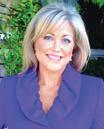
Sherri Snelling ’85 (SCJ/LAS), MA ’20 (GRN) , a corporate gerontolgist and CEO of Caregiving Club, published her second book, Me Time Monday: The Weekly Wellness Plan to Find Balance and Joy for a Busy Life.
Jill Apsit Fordyce ’86 (LAS) wrote Belonging, a debut novel published by Post Hill Press.
Ventura Charlin ’87 (LAS) co-wroteThe Worth of Art: Financial Tools for the Art Market, published by Columbia University Press.
Stephen Pfahler ’87 (BUS), JD ’90 (LAW) published The Whole Truth for Lawyers: A Complete Guide to Flourishing in Your Life and Career , with Gatekeeper Press.
Jerrold Abeles JD ’88 (LAW) was appointed as a Los Angeles Superior Court judge at the Stanley Mosk Courthouse in downtown Los Angeles.
Rob Ajemian JD ’88 (LAW) has been promoted to assistant general counsel at The Home Depot in Atlanta, Ga.
Russell West Jr. ’88 (LAS) earned a doctorate in instructional leadership at Hunter College. He serves as counsel at New Visions for Public Schools in New York City, where he was recently promoted to director of curriculum and instruction.
Kimberley Lovato ’90 (BUS) will publish her first children’s picture book, Pisa Loves Bella: A Towering Tale of Kindness, in July 2024.
Lynette Gridiron Winston JD ’90 (LAW) was appointed by Gov. Gavin Newsom as a judge for the Los Angeles County Superior Court.
Scott Armanini ’91 (BUS) has joined USC’s award-winning nonprofit, Frontida Records. Frontida was created by USC Global Innovation Challenge (Lives Not Grades) students for frontline health and aid workers
at Europe’s largest refugee camp (Camp Moria in Lesbos, Greece).
Toni Runkle ’92 (SCA) and Steve Webb ’93 (SCA) have written a new young adult novel called The Pirate’s Curse: Brigands of the Compass Rose published by Black Rose Writing.
Liz Atlee JD ’93 (LAW) was included in the Top 50 Diverse Board Candidates list by Equilar and the Nasdaq Center for Board Excellence. According to a press release, the list “is derived from nominations representing underrepresented demographic groups and candidates who do not yet serve on a public board.”
Lisa Harrington JD ’93 (LAW) was appointed as an independent board director and audit committee member at Slam Corp.
Casey Stone ’93 (MUS) received a Peabody Award for his work as a score mixer on the Disney+ television series Andor. Stone has recorded and mixed scores for acclaimed productions such as Free Guy, Edge of Tomorrow and Frozen.
Steven Thompson MS ’93 (ENG) is now at PricewaterhouseCoopers as the director of data engineering in the cloud and digital practice.
Terri Chan MS ’95 (ENG) was named associate technical fellow of the Enterprise Digital and Systems Engineering Functional Office at Boeing. In July, she was voted chair of the INCOSE Digital Engineering Information Exchange Working Group, working with leaders across the industry to create a set of standards and architecture frameworks for digital engineering. She also serves as an at-large USC Alumni Association Board of Governors member.
Kelwyn Pender ’95, MS ’07 (ENG) was promoted to director of Cyber Technical in Technology Risk Management at Capital One.
Lenita Skoretz JD ’96 (LAW) was appointed as judge to the San Bernardino Superior Court by Gov. Gavin Newsom.
Ana Bruzzese Biegert ’97, JD/MBT ’00 (LAW) was promoted to senior vice president of tax at Mattel in El Segundo, Calif.
Jennifer Gravley ’97 (LAS) has published her first book, The Story I Told My Mother: Poems and an Essay, from Twelve Winters Press.
Kevin Khoa Nguyen ’97 (GRN) is of counsel and director of human resources at STAR Inc., a California-based nonprofit educational organization, and professor of law and director of the School of Legal Studies at Abraham Lincoln University.
Christina Tusan JD ’97 (LAW) joined Hammond Law PC as partner, where she oversees the firm’s consumer protection class action and privacy litigation group. Tusan comes to Hammond Law after working at the Federal Trade Commission, the California Attorney General’s Office and the Los Angeles City Attorney’s Office.
Dawn Bittleston JD ’98 (LAW) was appointed to serve as a Kern County Superior Court judge.
Brietta Clark JD ’99 (LAW) has been named the Fritz B. Burns Dean of Loyola Law School, the first woman and first Black dean in the law school’s history. Clark had served as interim dean since July 16, 2023.
Justin Sanders JD ’00 (LAW) has been appointed to the Association of Business Trial Lawyers Board of Governors.
Justin Ward JD ’00 (LAW) received the Distinguished Attorney of the Year Award from the Sacramento County Bar Association.
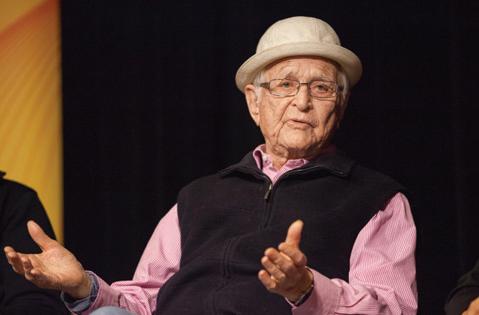
Legendary television writer and producer, businessman and philanthropist Norman M. Lear died on Dec. 5, 2023, in Los Angeles. He was 101. Perhaps best known for creating the character of Archie Bunker, the endearing bigot from 1970s sitcom All in the Family, Lear wrote and produced groundbreaking shows that revolutionized American television. He received a star on the Hollywood Walk of Fame in 1975, and in 1984, he became one of the seven inaugural honorees inducted into the Television Academy Hall of Fame. A fierce advocate for American democracy, Lear was also recognized for his political activism.
He created a nonprofit to protect constitutional rights and freedoms and launched a nonpartisan youth voter initiative.
Lear served on the Board of Councilors at the USC Annenberg School for Communication and Journalism beginning in 1998. He and his wife, Lyn Davis Lear, gave a $5 million gift in 2000 to establish USC Annenberg’s Norman Lear Center, which explores the impact of entertainment on society. They donated an additional $6 million in 2007 to create the Norman Lear Chair in Entertainment, Media and Society at USC Annenberg. USC awarded Lear an honorary doctorate in 2008.
Lear is survived by his wife; children, Kate, Maggie, Ellen, Benjamin, Brianna and Madeline; and four grandchildren.
Kimberly Carter JD ’01 (LAW) joined Epstein Becker & Green PC in the Los Angeles office as part of the Employment, Labor & Workforce Management Practice group. Carter is also chair of the Greater Los Angeles African American Chamber of Commerce’s Education Fund & Foundation.
Garrett Pendergraft ’01 (ENG) was recently named the Blanche E. Seaver Professor of Philosophy at Pepperdine University. He also serves as the primary faculty advisor for computer science and philosophy majors. In 2022, he published his first book, Free Will and Human Agency: 50 Puzzles, Paradoxes, and Thought Experiments (Routledge).
Ryan Williams JD ’01 (LAW) was appointed to serve as a Los Angeles County Superior Court judge.
Gary Lai ’02 (LAS) recently won a Goody Business Book Award for his book, Poverty and the Unequal Society in Hong Kong (Penguin Random House Southeast Asia).
Jennifer Malia ’02, PhD ’09 (LAS) wrote The Infinity Rainbow Club, a chapter book series published by Beaming Books. She was also promoted to professor of English at Norfolk State University.
Martha Enciso ’03 (LAS), ME ’06 (EDU), EdD ’09 (EDU) won the National Association of Student Personnel Administrators’ 2023 Mena Valdez Award. The associate vice president for student affairs at California State University, Fullerton, received the Outstanding Senior Student Affairs Officer Award, which is presented to those who have provided advice, energy, leadership and guidance to the Latino community.
Maura McGinnis Gibney ’03 (LAS), MSW ’06 (SSW) was named executive director of California Advocates for Nursing Home Reform, a statewide nonprofit organization focused on improving access to quality longterm care options.
Marc Habib ’03 (ENG) started two new corporations in real estate and construction and now helps investors identify, purchase, rehab and add value to passive income properties.
Maria Hall JD ’03 (LAW), along with her organization, Los Angeles Incubator Consortium, was chosen by legal technology firm Clio as a finalist for its 2023 Legal Impact Award.
Tracy Fehr JD ’05 (LAW) is a partner at Alexander Morrison Fehr LLP, which was included in the Daily Journal’s “Top Boutiques” for 2023.
Abbey Greenspan ’05 (SPP), JD ’10 (LAW) was promoted to deputy regional counsel for the U.S. Department of Housing and Urban Development’s Region IX office in San Francisco.
Cenk Temizel MS ’05 (ENG) has been awarded the Society of Petroleum Engineers Regional Reservoir Description and Dynamics Award.
Rachel Middleman ’06, PhD ’10 (LAS) was promoted to professor and appointed chair of the Department of Art and Art History at California State University, Chico.

Téa Obreht ’06 (LAS) has a new novel, The Morningside (Random House). Time magazine named it one of the Most Anticipated Books of 2024.
Rebecca (Becca) Yanniello ’06 (LAS) wrote A Kids Book About Public Health, published by A Kids Book About Inc.
Jordan Bowne ’07 (LAS) has joined Boston law firm Casner & Edwards as an associate in the firm’s Trusts & Estates Group.
Jennifer Lynn Stoever ’07 (LAS) was awarded a National Endowment for the Humanities Fellowship in 2023 and The George A. and Eliza Gardner Howard Foundation Fellowship at Brown University.
Austin Wintory ’07 (MUS) co-composed the score for the video game Stray Gods: The Roleplaying Musical developed by Summerfall Studios.
Ofunne Edoziem JD ’08 (LAW) released her young adult fantasy novel, The Herdsmen. Edoziem is a staff attorney in the financial services litigation group at Reed Smith.
Megan Garibaldi JD ’09 (LAW) of Best Best & Krieger LLP was appointed as city attorney for Long Beach, Calif.
Timothy McLaughlin ’09 (LAS) co-wrote Among the Braves: Hope, Struggle, and Exile in the Battle for Hong Kong and the Future of Global Democracy published by Hachette Books.
William Meyers JD ’09 (LAW) was recognized in the Los Angeles Business Journal’s “Leaders of Influence: Thriving in Their 40s 2023.”
Janani Rana JD ’09 (LAW), co-chair of the USC Gould Alumni Association of Orange County, has been elected partner at Minyard Morris LLP. In addition, she recently joined the Orange County Women Lawyers Association board of directors.
Ron Sasaki ’09 (ENG) joined the Darcy Partners, a technology scouting and market intelligence firm for the energy industry, as general manager. He oversees strategy and research in energy and sustainability technologies.
Dana Smith ’09 (LAS) was appointed to a permanent writing position at The New York Times.
Kevin Stanek ’09 (LAS) recently published his first book, Of Anchors & Sails: Personality-Ability Trait Constellations, and its primer, Our Constellations.
2010s
Steffi Hafen JD ’10 (LAW), a partner in Snell & Wilmer’s San Diego office, was included in the San Diego Business Journal’s 2023 “Top 100 Leaders in Law,” which recognizes outstanding legal professionals in the San Diego County legal community. In addition, she was selected as a finalist in the San Diego Business Journal’s “2023 Business Women of the Year Awards.”

Choose from 7 continents and 63 countries.

Book a cruise, rail trip, safari, small-group tour or … you decide!
Travel with fellow Trojans and friends.
We’ll manage the details so you can enjoy every minute!
Reserve your Trojan Travel adventure now to experience the world like never before...

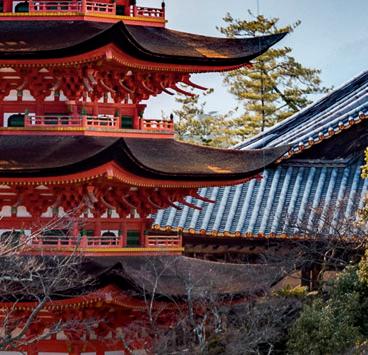





Whitney Hodges JD ’10 (LAW) was named a 2023 Commercial Real Estate Visionary by the Los Angeles Times.
Faustina Lee JD ’10 (LAW) was elected partner in the Los Angeles office of Tucker Ellis LLP. Lee’s practice focuses on intellectual property and internet law.
Becky Newman JD ’10 (LAW) joined For Purpose Law Group as of counsel in the firm’s nonprofit and tax-exempt organizations and charitable giving groups.
Ranjeet Sangle MS ’10 (ENG) was recently promoted to a managerial position at Cisco. He has permanently relocated to India after working in the San Jose, Calif., office for almost a decade. He will graduate from an executive MBA program at Indian Institute of Management Bangalore in April.
Jai-Ayla Sutherland ’10 (LAS) was unanimously elected by the Casper City Council, Wyo., to fill in the board’s empty Ward 1 seat.
Matthew Broaddus ’11 (LAS) wrote Temporal Anomalies, published by Ricochet Editions.
Diane Marie Brown ’11 (LAS) published her debut novel, Black Candle Women , which was chosen as a Today Show Read with Jenna book club selection. The book will also be adapted for television by Universal Television and Jenna Bush Hager.
Cristyn Chadwick JD ’11 (LAW) joined TroyGould PC as senior counsel and was installed as president of the Los Angeles Center for Law and Justice.
Shaun Gordon ’11 (BUS), JD ’14 (LAW) has been named to Variety’s 2023 Legal Impact Report as part of Weintraub Tobin’s audio team.
John Kreager ’11 (MUS), JD ’14 (LAW) was elected partner in the Los Angeles office of Simpson Thacher & Bartlett LLP, where he works in the firm’s private funds division.
Emily Reyes MAT ’11 (EDU) was elected to serve as second vice president of the Asian Pacific American Labor Alliance in August as a representative of the American
Federation of Teachers. She is a fifth grade teacher at Laurel Cinematic Arts & Creative Technologies Magnet in Los Angeles and serves on the School Site Council. She has been the United Teachers Los Angeles vice chair at her school site since 2020.
Daniel Warshawsky ’11 (LAS) is the author of Food Waste, Food Insecurity, and the Globalization of Food Banks, published in January.
Najeh Baharun JD/MBA ’12 (LAW) was elected as partner in the finance department of Willkie Farr & Gallagher LLP’s Los Angeles office.
Charles G. Bakaly IV ’12, JD ’17 (LAW) was named in the first Lawdragon 500 X — The Next Generation guide, “dedicated to those who will define where the legal profession of our country goes.”
Zachary Dooley MS ’12 (ENG) was recently elected to the Biomedical Engineering Society Board of Directors for a three-year term.
Jeffery Elder JD ’12 (LAW) was promoted to chief counsel and director of legal services at the Southern California Association of Governments. Elder is a member of the USC Gould Alumni Association Los Angeles Committee.

Robert A. Day, the longtime leader of the W. M. Keck Foundation whose vision was instrumental to the growth of USC and the well-being of Los Angeles, died on Sept. 14, 2023, at age 79.
A businessman, investor and philanthropist, Day profoundly changed the course of USC, its medical school, the Keck School of Medicine of USC and Keck Medicine of USC. The Keck Foundation advanced programs that continue to improve health and education for countless people in Los Angeles and across the
world. Under Day’s leadership, the foundation drove the transformative naming gifts for USC’s medical school in 1999 and its health system in 2011; his contributions are visible every day in the university’s hospitals, clinics, research labs and classrooms.
The Keck Foundation remains deeply committed to the university. Throughout its nearly 70-year history, the Keck Foundation has endowed chairs to attract and retain top USC professors in areas such as geological sciences and engineering; supported the USC-owned radio network based at KUSC; provided grants for urgent needs, including COVID-19 research; and created research centers that drive innovation across USC.
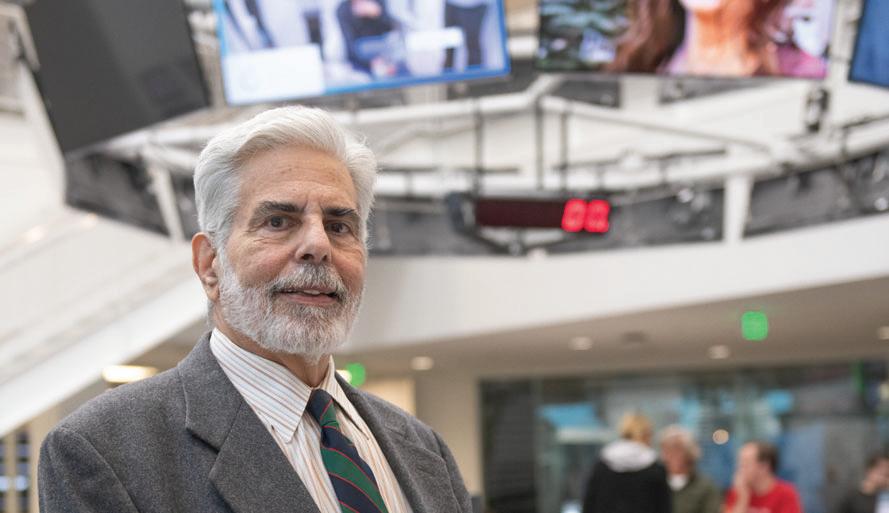


What Will Your
Trojan Legacy Be?


As a young man, Larry Kaplan M A ’78 was look ing for a radio station job when a chance encounter with USC Annenberg School for Communication and Journalism Professor Joe Saltzman changed his life. Saltzman persuaded Larry to apply to USC Annenberg’s graduate program, which included a teaching assistant position. Forever grateful for the opportunities he received at and because of USC, Larry has designated an estate gift to the USC Annenberg Journalism Fund.
To create your Trojan legacy, contact the USC Office of Gift Planning at (213) 740-2682 or giftplanning@usc.edu. Please visit us online at usc.planmygift.org.
“Being a teaching assistant and getting paid a stipend allowed me to earn a degree at one of the best schools in the country. It’s my turn to give back to USC.”
Larry kaplan ma ’78
Matthew Jellick MAT ’12 (EDU) was selected to be an English-language specialist on behalf of the U.S. Embassy in Djibouti. While there, he worked with the Djiboutian Ministry of Education and local teachers on refining their research topics for presentations.
Alfonso Jiménez EdD ’12 (EDU), superintendent of Hacienda La Puente Unified School District, was named a 2022 Superintendent to Watch by the National School Public Relations Association. He also was named the 2022 University of California, Davis, C-STEM Center Superintendent of the Year and the 2023 California Association for Latino Superintendents and Administrators Region V Superintendent of the Year.
Taylor Maun ’12 (BUS) was elected to partner at the law firm Polsinelli.
Padma Sundaram MS ’12 (ENG) started a new position as vice president of automotive technology and engineering at HCLTech in Troy, Mich.
Annette A. Wong JD ’12 (LAW) was included in the 2024 Best Lawyers “Ones to Watch” list.
Ryan Appleby JD ’13 (LAW) was promoted to partner in the Litigation department of Gibson, Dunn & Crutcher LLP’s Los Angeles office.
Lindsay Barstow JD ’13 (LAW) has been elected as counsel in the Los Angeles office of Saul Ewing LLP, where she is a member of the firm’s real estate division.
Jennifer M. Black ’13 (LAS) wrote Branding Trust: Advertising and Trademarks in Nineteenth-Century America, published by the University of Pennsylvania Press.
Jordan Cook JD ’13 (LAW) was promoted to counsel at Latham & Watkins LLP’s Costa Mesa office. She is a member of the firm’s Securities Litigation & Professional Liability practice and Litigation & Trial department.
Nicole Gates JD ’13 (LAW) was promoted to vice president, legal at Dr. Seuss Enterprises LP.
Rocío Hernández EdD ’13 (EDU) is the author of Diverse Experiences of Latinas in Higher Education: Chingonas on Their Own Terms published by Routledge in 2023.
Marco Nava EdD ’13 (EDU), with Imelda L. Nava and Jan Kirsch, is the co-author of “Leadership That Bridges Arts and SocialEmotional Learning.” The article was published in the Oxford Research Encyclopedia of Education. Marco was also one of 16 fellows selected to the inaugural National Leadership Institute of Men of Color in Educational Leadership.
Jennifer Sayles Okorn JD ’13 (LAW) was elected to partner in Gunderson Dettmer LLP’s Los Angeles office.
Cynthia Organ JD ’13 (LAW) was promoted to partner in the litigation department at Glaser Weil.
Michael Santos ’13 (LAW) has been named chair of the American Bar Association Commission on Homelessness and Poverty. Santos plans to use his role to educate the public about the legal problems of people experiencing homelessness and poverty.

Jianxin Sun ’13 (ARC) was recently promoted to director of housing at Los Angeles-based Relativity Architects. He will oversee the firm’s affordable and market-rate housing projects for low-income families, seniors and veterans.
Ryan Walsh JD ’13 (LAW) was promoted to counsel at Latham & Watkins LLP’s office in Costa Mesa, Calif. He is a member of the firm’s Securities Litigation & Professional Liability practice and Litigation & Trial department.

Jenny Wong MM ’13, DMA ’17 (MUS) was named chorus director of the San Francisco Symphony. Wong is the fourth choral conductor to lead the ensemble in its 50-year history.
Abdullah Alsaeed ’14 (LAW) was elected partner in Latham and Watkins LLP’s Riyadh office in Saudi Arabia, where he is a member of the White Collar Defense & Investigations practice and Litigation & Trial department. He represents clients in Saudi Arabia and globally on regulatory and commercial litigation matters.
Leena Bakshi EdD ’14 (EDU) is the founder of STEM4Real, an organization committed to increasing the school-to-STEM career pipeline, especially for underrepresented students of color. She was also selected to join Education Leaders of Color, a membership organization dedicated to ensuring young people of color have the support they need to thrive, capitalize on opportunities and build generational wealth.
Cale Bouchey ’14 (LAS) joined Carmody MacDonald P.C. as an attorney in the firm’s business and transactional group.
Hannah Cary JD ’14 (LAW) was promoted to counsel at Latham & WatkinsLLP in San Diego. She is a member of the firm’s Mergers & Acquisitions and Private Equity Practice and Corporated Department.
Omar Noureldin JD ’14 (LAW) was appointed senior counsel to the Assistant Attorney General for Civil Rights at the U.S. Department of Justice in Washington, D.C.
Juan Carlos Olivares JD ’14 (LAW) was promoted to counsel at Latham & Watkins LLP’s Los Angeles office. He is a member of the firm’s Banking Practice and Finance department.
Since the USC Alumni Association’s founding in 1923, alumni have demonstrated the importance of staying connected to our university and defined what it means to be a member of our Trojan Family, lifelong and worldwide.
Mark this milestone with us:
• Share your USC stories through our Centennial Mosaic and on social media
• Support student scholarships through our Centennial Philanthropy Initiative
• Update your profile and customize your experience in the FightOnline portal
• Connect with fellow Trojans at events, and more!
Together we can shape the future. Let’s make the next 100 years as extraordinary as the first! Visit alumni.usc.edu/alumni100.
Ranjan Pal PhD ’14 (ENG), a research scientist at the MIT Sloan School of Management, is an elected member of the World Economic Forum Group on Cyber-Resilience.
Meghan McLean Poon JD ’14 (LAW) was named partner in the Palo Alto office of Morrison Foerster LLP, where she works in the firm’s transactions department and the Patent Strategy + Prosecution group.

Ashima Sharma ’14 (ENG) created the startup Dreami in 2021 to facilitate mentorship and career support. The National Science Foundation recently announced support for Dreami. Last August, Dreami was chosen as part of the Google for Startups Accelerator: Women Founders class of 2023.
Vigor Lam ME ’15 (EDU) is a founder of BuildOUT California and a senior project engineer with Jacobs. He was awarded the Emerging Professional Award from the Northern California Chapter of Construction Management Association of America.
Richard Lockridge JD ’15 (LAW) was elected partner at McGuireWoods’ Charlotte, N.C., office.
Timur Tusiray JD ’15 (LAW) has joined PayPal Inc. as senior legal counsel.
Julio Vincent Gambuto ’16 (SCJ) is touring the country to promote his new book, Please Unsubscribe, Thanks!
Chase Millsap ’16 (SPP) directed Small Town Strong out on Apple TV+, Amazon and Vimeo.
Katie Stump ’16 (MUS), also known as Blü Eyes, went on her first sold-out tour around North America and Europe in fall 2023.
Amanda Kennell ’17 (LAS) published Alice in Japanese Wonderlands, an adaptation of Lewis Carroll’s Alice in Wonderland novels. She also began a new job at the University of Notre Dame as an assistant professor of East Asian languages and cultures.
Lacey Kline MS ’17 (ENG) is a senior systems engineering contractor supporting Virgin Galactic’s newest spaceship, Delta.
Jessper Maquindang ’17 (SPP) is a team building and leadership development trainer for FamiLEAD Management Consulting.
Amie Carter EdD ’18 (EDU) was elected Sonoma County superintendent of schools. She is the first woman to be elected to this county office in more than 100 years. She is also only the second openly LGBTQ+ county superintendent in the state of California.
Elise Solberg ’18 (MUS) performed as the keyboardist in Chlöe Bailey’s band for NPR’s Tiny Desk Concert in September. In 2022, Solberg joined Beyoncé’s band at the 94th Academy Awards, playing the keys for her Oscar-nominated song “Be Alive.”
Michael Zink ’18 (ENG) was hired as a senior product manager at RentSpree, a tenant screening and rental platform.
Sofia Rinvil ’19 (LAW) joined the New York City Council as a legislative fellow for the Office of NYC Council Member Carlina Rivera.
Christina Chavez MAT ’20 (EDU) was awarded the Fund For Teachers Fellowship in summer 2023. She traveled to Washington, D.C., Germany and Poland to research the wartime account of Mexican American prisoner of war Anthony Acevedo and his role in preserving the historical record of World War II and the Holocaust. She teaches in Montebello Unified School District.
James Crowe ’20 (SSW) was appointed to the District of Columbia Health Information Exchange Policy Board by Mayor Muriel Bowser. The board provides recommendations on the secure and protected exchange of health information in the district.
Branden Grimmett EdD ’20 (EDU) was nominated for a Tony Award as co-producer of the Broadway musical New York,

John Brooks Slaughter, a distinguished leader in the fields of engineering and education, died on Dec. 6, 2023, at the age of 89 from cancer.
Slaughter’s legacy is woven into the fabric of the USC Viterbi School of Engineering and the USC Rossier School of Education, where he served as a University Professor Emeritus of Education and Electrical and Computer Engineering and played a pivotal role in shaping inclusivity and excellence.
As the first Black director of the National Science Foundation, the first Black president of Occidental College and the first Black chancellor of the University of Maryland, Slaughter was an example of the resilience and relentless commitment required to break down barriers.
During an interview with USC Viterbi’s Escape Velocity podcast in 2020, he noted: “In eighth grade, I [decided I wanted] to be an engineer. People laughed at me not because I wanted to be an engineer, but [because] they [had] never seen a Black person who was an engineer.”
He joined USC Viterbi as a Distinguished Professor of engineering with a joint appointment at the USC Rossier in 2010. Working closely with the Minority Engineering Program, established at USC in 1975, he laid the foundation for what would become the Center for Engineering Diversity (CED) in 1997. He also collaborated with the CED staff to establish a faculty advisory board.
Slaughter’s impact extended far beyond his engineering achievements. His commitment to mentoring earned him the Presidential Award for Excellence in Science, Mathematics and Engineering Mentoring in 2015.
In September 2023, the CED was renamed the John Brooks Slaughter Center for Engineering Diversity, a tribute to Slaughter’s tireless efforts to foster an inclusive environment for underrepresented minority students.
Ne w York. The musical was nominated for nine Tony Awards, including Best Musical.
Ronald Gomez JD ’20 (LAW) was elected to the Los Angeles Mexican American Bar Association’s board of trustees.
Faisal Khairy ’20 (LAW) joined Insurance Authority in Riyadh, Saudi Arabia, as a senior legal specialist.
Salem Al Mudhaf ’21 (ENG) joined McKinsey & Company as a business analyst in their Middle East office.
Gary Saunders II ’21 (EDU) is serving as the superintendent and principal of Sierra Foothill Charter.
Jamie Smith ’21 (ENG) works at Relativity Space, where he helped create firmware for the Terran 1 rocket. This code conveyed vital sensor data to the flight computer and enabled the rocket to fly past the Karman Line and into space.
Amy Wong EdD ’21 (EDU) published her dissertation as a book. Stories of Survival: The Paradox of Suicide Vulnerability and Resiliency Among Asian American College Students was released by Oxford University Press in 2023.
David Barrett ’22 (ENG) was hired as a software engineer at Electronic Arts, where he works at Maxis Studios on the critically acclaimed game The Sims 4 and the yet-to-be-released Project Rene .

Patricia Garcia MS ’22 (ENG) won the Fulbright Entrepreneurship Award for her award-winning company, Unithrifts. She recently moved to London.
Quenton Blache ’23 (MUS) made his Carnegie Hall debut with the chamber orchestra Sphinx Virtuosi in October 2023 at the Stern Auditorium/Perelman Stage.
Zandra Jo Galván EdD ’23 (EDU), superintendent of Greenfield Union School District, was named Superintendent of the Year by
the Association of Latino Administrators and Superintendents. She was also one of 24 Google Global Silicon Valley Education Innovation Fellows for 2023-2024. This inaugural cohort of fellows features exceptional K-12 instrutional leaders dedicated to leveraging technology to transform education.
Maitreyee Likhite MS ’23 (ENG) joined Qualcomm, San Diego as an AI/ML engineer in the AI/ML IoT Connected Camera Systems team.
Edward Mena ’99 (MED) , MBA ’22 (BUS) and Sofia Mena ’22 (BUS) in Nicaragua, November 2023.
Seth Rubinroit ’13 (BUS) and Alexandra Criscuolo in New York, June 2023.
Derek Corbin ’17 (LAS) and Megan White in Rockville, Md., October 2023.

Ari Mandell ’17 (BUS) JD ’22 (LAW) and Dominique DeMirjian Mandell ’19 (ART) in Beverly Hills, Calif., May 2023.
Allen Huang ’19 (LAS) and Lindsay Marty ’19 (LAS) in Squaw Valley, Calif., May 2023.
Thomas Mesenbring Field ’02 (LAS) and Lindsay (Menes) Field ’04 (LAS), a son, River James Phoenix Field.
Natasha Godoy-Vaca ’07 (SPP) and Jose Vaca ’07 (BPT) a daughter, Jayla Neoma Vaca.
Arthur Yen ’08 (BUS) and Stefani Roberts ’09 (SCJ), a son, Theodore Henry Roberts Yen.
Michelle (Kim) Cullen ’11 (ENG) and Dallas Cullen, a son, James.
Quark Henares ’13 (BUS) and Bianca Yuzon, a son, Constantine Cassian.
Heather McAfee MS ’21 (ENG) and Hamied Shirazi, twin boys, Nico and Roman.
Aurora Lokka ’50 (LAS), MS ’51 (EDU) of Sonoma, Calif.; July 4, 2023, at the age of 94.
Chad Boliek ’51 (LAS) of Santa Fe, N.M.; March 21, 2023, at the age of 95.
William Cunningham ’51 (LAS) of Redlands, Calif.; Aug. 16, 2023, at the age of 96.
Clifford Rettig ’51 (LAS) of Watsonville, Calif.; Aug. 6, 2023, at the age of 98.
Richard Paul Brombach ’53 (BUS) of Palos Verdes Estates, Calif.; March 19, 2022, at the age of 92.
John (Jack) Gurley ’54 (LAS) of Pasadena, Calif.; Aug. 15, 2023, at the age of 90.
David Price ’54 (LAS) of Culver City, Calif.; Oct. 31, 2023, at the age of 91.
Donald Lockwood Burge ’56 (LAS) of Monrovia, Calif.; March 23, 2023, at the age of 88.
Leslie Joe Enloe ’57 (LAS), MD ’60 (MED) of Orinda, Calif.; July 17, 2023, at the age of 87.
Roger Harris ’57 (LAS), DDS ’61 (DEN) of Indian Wells, Calif.; Aug. 19, 2023, at the age of 88.
Wilmer Ernest Windham ’59 (LAW) of Los Angeles; Nov. 4, 2023, at the age of 90.
Robert Slavens ’60 (LAS) of Manlius, N.Y.; July 20, 2023, at the age of 86.
Richard Arra Bedrosian ’61 (ENG) of Granada Hills, Calif.; Aug. 27, 2023, at the age of 92.
Jay Berman ’61, MA ’74 (LAS) of Manhattan Beach, Calif.; June 9, 2023, at the age of 83.
Harry Hathaway JD ’62 (LAW) of Los Angeles; Oct. 5, 2023, at the age of 86.
Shirley Freschi ’63 (LAS) of Carmel, Calif.; May 8, 2023, at the age of 95.
Ben Ivery Wilson ’63 (LAS), MBA ’70 (BUS) of Monticello, Ark.; July 29, 2023, at the age of 84.
Marshall Bruce Grossman JD ’64 (LAW) of Los Angeles; Sept. 30, 2023, at the age of 84.
Carlos De La Rosa ’65 (LAS) of Los Angeles; Aug. 30, 2023, at the age of 79.
Stephen Langs ’65 (LAS) of Santa Rosa, Calif.; March 28, 2023, at the age of 80.
Michael H. Dougherty JD ’66 (LAW) of San Clemente, Calif.; July 10, 2023, at the age of 88.
Gary Goettelmann ’66 (LAS) of Los Angeles; Jan. 17, 2023, at the age of 79.
Hank Waller ’66, MBA ’76 (BUS) of Colleyville, Texas; Sept. 15, 2023, at the age of 78.
Yukio Machii ’67 (ENG) of Nagano, Japan; Aug. 13, 2023, at the age of 85.
John Gerardin Cole ’68 (PHM) of Pismo Beach, Calif.; April 4, 2023, at the age of 79.
James Anthony Brown ’70 (LAS) of Euclid, Ohio; Sep. 8, 2023, at the age of 91.
George Harvey Walters ’70 (DEN) of Omaha, Neb.; April 15, 2022, at the age of 86.
Frank George Dagerman ’71 (LAS) , MBA ’78 (BUS), of San Juan Capistrano, Calif.; Dec. 13, 2022, at the age of 76.
Edward Thurber ’71 (LAS) of Fullerton, Calif.; July 9, 2023, at the age of 82.
Richard Gunther ’74 (LAS) of Santa Barbara, Calif.; May 25, 2023, at the age of 98.
Jerry Dale Pond ’76 (PHM) of Thousand Oaks, Calif.; Jan. 7, 2023, at the age of 76.
Russell Miller ’82 (MUS) of Bowling Green, Ohio; July 22, 2023, at age 63.
Richard Bogy ’83 (LAS) of Toluca Lake, Calif.; Aug. 24, 2023, at the age of 62.
Lois (Dargen) Heying ’83 (OST) of Portland, Ore.; Feb. 23, 2023, at the age of 78.
Fred Bertetta III ’87 (LAS) of Burlingame, Calif.; Aug. 1, 2023, at the age of 58.
Luiz André Barroso PhD ’96 (ENG) of Los Altos, Calif.; Sept. 16, 2023, at the age of 59.
Michael Kerr JD ’96 (LAW) of Naperville, Ill.; Dec. 13, 2023, at the age of 53.
Wayne Marko ’97 (LAS) of Chicago, Ill.; June 19, 2023, at the age of 49.
Eric Mah-Hing ’09 (MUS) of Seattle, Wash.; July 6, 2023, at the age of 35.
Stephen Matthew Black DMA ’15 (MUS) of Louisville, Ky.; June 25, 2023, at the age of 55.
Luke L. Mueller ’15 (SCA) of Stanhope, N.J.; July 7, 2022, at the age of 32.
ACC USC Leventhal School of Accounting
ARC USC School of Architecture
ART USC Roski School of Art and Design
BPT Division of Biokinesiology and Physical Therapy
BUS USC Marshall School of Business
DEN Herman Ostrow School of Dentistry of USC
DNC USC Kaufman School of Dance
DRA USC School of Dramatic Arts
EDU USC Rossier School of Education
ENG USC Viterbi School of Engineering
GRD USC Graduate School
GRN USC Leonard Davis School of Gerontology
IYA USC Iovine and Young Academy
LAS USC Dornsife College of Letters, Arts and Sciences
LAW USC Gould School of Law
MED Keck School of Medicine of USC
MUS USC Thornton School of Music
OST USC Chan Division of Occupational Science and Occupational Therapy
PHM USC School of Pharmacy
SCA USC School of Cinematic Arts
SCJ USC Annenberg School for Communication and Journalism
SPP USC Price School of Public Policy
SSW USC Suzanne Dworak-Peck School of Social Work
Tom Arteaga, Chloe Barker, Crisann BegleySmith, Alexander Bernard, Maeve Harding, Kianoosh Hashemzadeh, Demetrius Ly, Leticia Lozoya, Katie Maloney, Alex Rast, Justin Wilson, Sabrina Skacan and Nicole Stark contributed to this section.
Have an idea for an imagined vision of USC? Email it to magazines@usc.edu.

An environmental studies student spent her summer collecting data about the flora and fauna of Catalina Island. BY
VANESSA CODILLA
Audrey Stavish knew spending the summer on scenic Catalina Island would be a dream come true — just not how you’d think. The environmental studies major at the USC Dornsife College of Letters, Arts and Sciences spent 10 weeks on the island working in habitat preservation and restoration through an internship with the Catalina Island Conservancy funded by the USC Wrigley Institute for Environment and Sustainability.
Stavish and her peers gained a unique perspective on Catalina Island’s natural and cultural history and hands-on knowledge while supporting the conservancy’s wildlife and
plant management programs. They went on numerous field surveys around the island, home to nine endemic plant species and more than 40 rare ones.
One of the conservancy’s most notable wildlife initiatives is its effort to revive the Catalina Island fox population, which neared extinction in the late 1990s. Its various efforts to protect this keystone species involve vaccinating them annually, radio collar monitoring and identifying causes behind fox deaths.
Every other week, Stavish helped with monitoring efforts using telemetry technology to track and collect data on the island foxes.
“We [drove] around the island to make sure we [were] hearing a signal from each of the collared foxes [indicating] they’re alive,” Stavish says. Monitoring the foxes helped provide information about any sudden population declines. “If there is a new virus, we can get ahead of the threat with our trapping efforts and vaccinate them.”
Working on different projects during her internship helped Stavish develop various skill sets. “Being here and learning how things work is helpful to contextualize what conservation actually looks like,” says Stavish. “I love working in this field.”
No matter what dreams you may have on the horizon, our expert health care team is here to partner with you to realize your potential. That’s what happens when deep expertise combines with truly personalized care. Together we are limitless.
Keck Hospital of USC
USC Arcadia Hospital
USC Care Medical Group
USC Norris Cancer Hospital
USC Verdugo Hills Hospital


University of Southern California
Los Angeles, CA 90089-2818
Change Service Requested
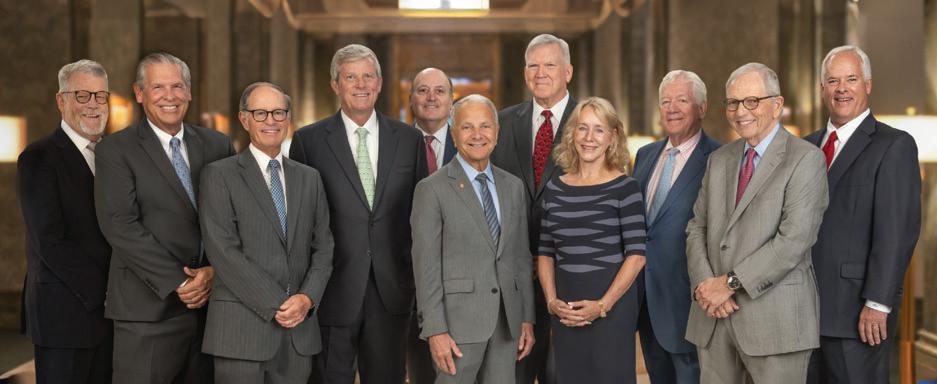
Whittier Trust’s growth from a single-family to a trusted multi-family office is the result of our unwavering commitment to our clients. Guiding our company is a Board of individuals who exemplify our core business beliefs of integrity, reliability, and empathy. We are grateful to all of our Directors for their thoughtful insight and commitment to our legacy of providing a level of service that aims to exceed client expectation.
